Order these records by:
Browse Collection › LC Subject Heading › 242 records found where LC Subject Heading is Durham (N.C.) -- History | ||
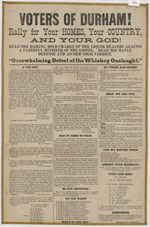 | Voters of Durham! rally for your homes, your country, and your God! The Prohibition Committee of Durham, North Carolina, created this broadside in 1886, to support a slate of candidates who vowed to abolish the sale of liquor. J.F. Freeland ran for mayor while Edward J. Parrish, G. W. Watts, C. C. Taylor, W. J. Wyatt, J. S. Carr, T. M. Stephens and J. S. Durham sought positions as town commissioners. The broadside reproduces an exchange in the Durham Recorder, between liquor dealers and church officials over whether a father sold his children's clothing to purchase alcohol. | |
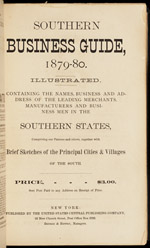 | Southern Business Guide (Excerpt) This section of the Southern Business Guide 1879-1880 contains the names of the leading merchants, manufacturers, and entrepreneurs of Durham, North Carolina. The guide lists, in alphabetical order, 54 businesses. Includes listings for businesses on Main Street as well as W. Duke, Sons and Company, Atlas Rigsbee's General Store, R. H. Wright & Company and W. T. Blackwell & Company. | |
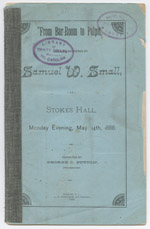 | From the bar-room to pulpit: lecture delivered by Samuel W. Small at Stokes Hall, Monday evening, May 14th, 1888 A prohibition lecture delivered at Stokes Hall, Durham by Atlanta evangelist Samuel Small. Small recollects his encounters with Sam P. Jones and his personal conversion from drunkard to prohibitionist. | |
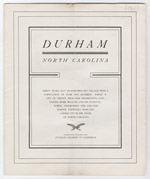 | Durham, North Carolina : thirty years ago an insignificant village with a population of some five hundred A Durham Chamber of Commerce booklet, published in 1906, which presents a short history of Durham as well as numerous photographic illustrations of educational institutions, churches, manufacturing establishments and street scenes. The pamphlet also includes statistical information about Durham County and its schools. | |
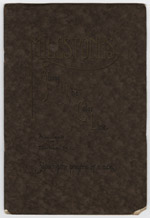 | Milestones along the color line. A souvenir of Durham, North Carolina showing the progress of a race Oliver B.Quick created Milestones Along the Color Line. A Souvenir of Durham, North Carolina Showing the Progress of a Race, to show property “owned and controlled exclusively by Negroes in the city of Durham, N.C.” In his preface he noted, “we have selected these [institutions and homes] as evidence of the progress being made by our race group in this section of the South.” The pamphlet contains numerous photographic images of churches, schools, business establishments, private residences and street scenes. | |
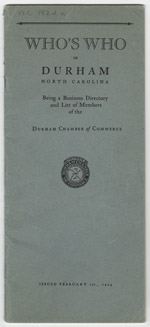 | Who's who in Durham, North Carolina ,being a business directory and list of members of the Durham Chamber of Commerce This 1924 Durham Chamber of Commerce publication contains information about the Chamber and its membership. The pamphlet provides an alphabetical listing of individual members, a classified business directory, and a section of “facts about Durham.” | |
 | Ordinances and resolutions for the government of the town of Durham, 1873 This 1873 pamphlet records laws for Durham's citizens and visitors. Includes prohibitions on cockfighting, littering, indecent exposure, and firing guns within town limits. Julian S. Carr held the post of mayor of Durham. Edward James Parrish, J. E. Lyon, J. F. Freeland, W. Mangum and James S. Lockhart served on the Durham Board of Commissioners. | |
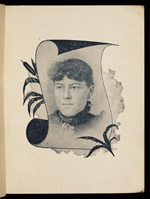 | My thoughts : A book of poems. With an introduction by James E. Shepard. M. Pauline Fitzgerald, one of Durham’s first African American school teachers, penned this self-published book of poetry. Pauline’s poetry memorializes Frederick Douglass, Dr. H. M. Tupper, founder and first president of Shaw University, and Bishop Daniel Payne of the A.M.E. Church. The collection also includes some more personal pieces including “An Ode to the First Colored Drug Store in Durham, North Carolina” and “The School Mistress.” Pauli Murray, author of Proud Shoes: The Story of an American Family relates a number of stories about her “Aunt Pauline” in her biographical account of M. Pauline Fitzgerald’s parents, Robert G. and Cornelia Fitzgerald. | |
 | Gray's new map of Durham, 1881 This cadastral map from 1881 depicts buildings, street names, businesses, property owners, and railroads in Durham, North Carolina. Scale 350 feet = 1 inch or [ca. 1:4,200]. | |
 | Lavenia Blackwell report card Report card for Lavenia Blackwell from the Oxford Female Seminary in Oxford, North Carolina. While attending this boarding school in 1881, Lavenia studied four subjects: Preparatory (spelling, penmanship, written and mental arithmetic), Languages (Latin and French), Music (instrumental and vocal), and Fine Arts (crayon drawing). | |
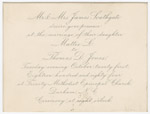 | Invitation to the wedding of Mattie Southgate to Thomas Decatur Jones Invitation to the wedding of Thomas Decatur Jones and Mattie Southgate, scheduled for Tuesday, October 21st, 1884, at the Trinity Methodist Episcopal Church in Durham, North Carolina. | |
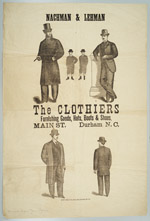 | Nachman and Lehman advertisements Poster promoting products for Nachman and Lehman, a firm that sold clothes, furnishings, hats, shoes, boots, and other goods in Durham, North Carolina. The store was located on Main Street. | |
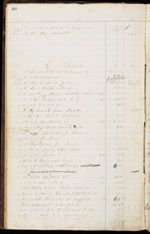 | Edward James Parrish account Atlas Rigsbee's ledger book provides insight into the nature of commerce in late nineteenth-century Durham. These pages reflect what products tobacco dealer Edward James Parrish purchased from the general store in 1880. This account provides information about the cost and availability of staple foods like eggs, meal, butter, salt, sugar, lard, and chicken, as well as luxury items like cherries and goblets. | |
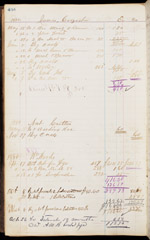 | James Cozart account These financial records indicate what products James Cozart, an African American farmer, purchased from the Atlas M. Rigsbee general store in 1880. This ledger account provides information about the cost and availability of staple foods like bacon, corn, and meal as well as hardware like plow points. | |
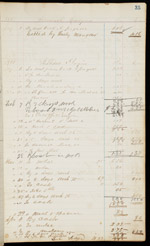 | William Hogan account These financial records indicate what products William Hogan, an African American farm laborer, purchased from the Atlas M. Rigsbee general store in 1880. This ledger account provides information about the cost and availability of staple foods like bacon, corn, and meal as well as coffee, sugar, tobacco, and ham. The account also reveals that Hogan paid for his goods with his labor. | |
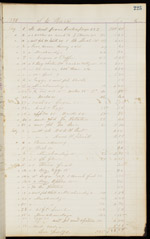 | Spencer E. Watts account These financial records indicate what products Spencer Watts, a merchant, purchased from the Atlas M. Rigsbee general store in 1880. This ledger account provides information about the cost and availability of staple foods like oil, eggs, butter, and flour as well as more costly items like chicken, fish, apples, men's clothing, parasols, and shoes. | |
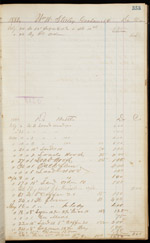 | Dr. Lee Battle account These financial records indicate what products Lee W. Battle, a physician, purchased from the Atlas M. Rigsbee general store in 1880. This ledger account provides information about the cost and availability of foods like oil, eggs, butter, lard, and flour, as well as luxury items like coffeee, rice, pepper, mace and cloves. The account indicates that Dr. Battle paid cash for his goods. | |
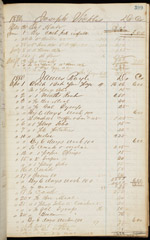 | James Rayle account These financial records indicate what products James Rayle, a machinist, purchased from the Atlas M. Rigsbee general store in 1880. This ledger account provides information about the cost and availability of coffee, lard, oil, sugar, bacon, potatoes and tobacco. The account indicates that James Rayle paid for his goods and rent with his labor. | |
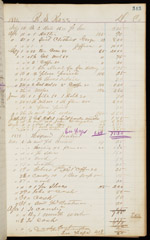 | Haywood Jenkins account These financial records indicate what products Haywood Jenkins, an African American factory hand, purchased from the Atlas M. Rigsbee general store in 1880. This ledger account provides information about the cost and availability of foods like meal, fish, lard as well as tobacco and snuff. The account indicates that Haywood Jenkins purchased goods in exchange for his labor. | |
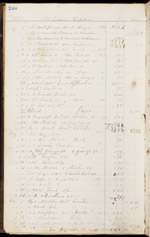 | Susan Hopkins account These financial records indicate what products Susan Hopkins, a widow and boarding-house proprietor, purchased from the Atlas M. Rigsbee general store in 1880. This ledger account provides information about the cost and availability of staple foods like oil, eggs, butter, lard, and flour as well as more costly items like chicken and ham. The account indicates that Mrs. Hopkins procured goods with cash and in exchange for boarding Rigsbee's employees. | |
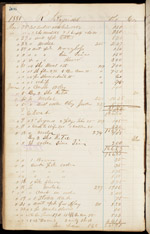 | Richard Fitzgerald account These pages from the Atlas M. Rigsbee, General Store ledger indicate what products, Richard Fitzgerald purchased from the Atlas M. Rigsbee General Store in 1880. Fitzgerald, an African American brickmaker, purchased a range of goods including foodstuffs like flour, meal, butter, sugar, and fish as well as lamp chimneys, collars and hats. The ledger indicates that Fitzgerald paid for his goods with bricks from his manufacturing enterprise. | |
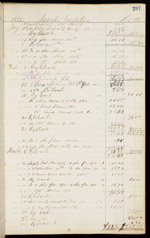 | Jacob Goldstein account These financial records indicate what products Jacob Goldstein, a, jewish immigrant and merchant, purchased from the Atlas M. Rigsbee general store in 1880. This ledger account provides information about the cost and availability of foodstuffs like bacon, meal, flour and salt. | |
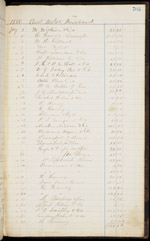 | Atlas M. Rigsbee account detailing merchandise purchased from January 5, 1880 to Sept 14,1880 These pages document the total amount of merchandise Atlas M. Rigsbee purchased from January 5, 1880 to September 14, 1880. Rigsbee procured agricultural products from North Carolina farmers. He also purchased manufactured products as well as foodstuffs from suppliers in North Carolina, Virginia, Maryland, New York, and Ohio. These pages list the names of the firms that supplied merchandise to the Atlas M. Rigsbee general store. | |
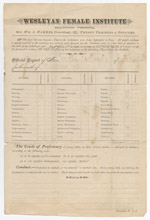 | Mattie Southgate report card, February 1882 1882 report card for Mattie Southgate from the Wesleyan Female Institute at Staunton, Viriginia. Mattie studied writing, natural philosophy, rhetoric, elocution, French, German, vocal music, instrumental music, calisthenics, and conduct. | |
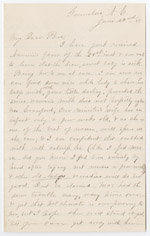 | Letter from Lucy W. Ball to Richard Harvey Wright, June 22, 1885 Lucy Wright Ball sends her brother Richard Harvey Wright advice on feeding his infant daughter, Mamie E. Wright. Richard had lost his wife, Mamie Exum Wright, in childbirth and his sister Nannie had assumed responsibility for his newborn daughter. Lucy includes a separate note for her sister Nannie Wright where she expresses her concern for her niece's health and tries to persuade her siblings to bring young Mamie to Greensboro. She offers to help secure a wet nurse for her infant niece and suggests hand feeding the baby with scalded milk and catnip tea. | |
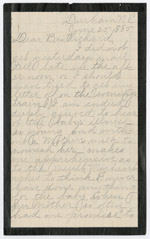 | Letter from Annie E. Snow to Richard Harvey Wright, June 25, 1885 Annie E. Snow sends her brother-in-law Richard H. Wright nutritional advice for his baby daughter. She tells Richard she has been in poor health and cannot consider travel. She recollects her sister's death in childbirth and lauds Richard's efforts to keep his infant daughter alive. | |
 | Letter from Lucy W. Ball to Richard Harvey Wright, August 1885 Lucy attempts to console her brother Richard Harvey Wright after the death of his wife, Mamie Exum Wright. She also discusses tensions in the tobacco industry between the Duke family and her brother. | |
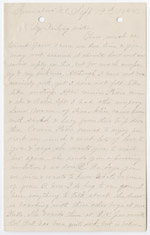 | Letter from Lucy W. Ball to Richard Harvey Wright, September 19, 1885 Lucy shares news of her health with her brother Richard Harvey Wright and offers him advice on how to feed his baby daughter, Little May. | |
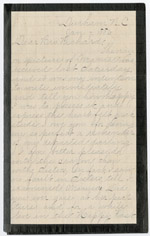 | Letter from Annie E. Snow to Richard Harvey Wright, January 07, 1886 Annie E. Snow writes her brother-in-law Richard H. Wright about the difficulties she encounters with Mr. Linthicum who she hired to move and beautify the grave of Richard H. Wright's deceased wife, Mamie Exum Wright. She also thanks Richard for sending her a crayon drawing of her sister Mamie. | |
 | Letter from Annie E. Snow to Richard Harvey Wright, March 10, 1886 Annie E. Snow writes her brother-in-law, Richard Harvey Wright, with suggestions about selecting appropriate monuments for the grave of his deceased wife, Mamie Exum Wright. | |
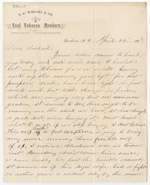 | Letter from Thomas D. Wright to Richard Harvey Wright, April 26, 1886 Thomas D. Wright describes an altercation and "fight" between two women and the public's response to Mr. Blackwell's sudden departure to Raleigh. | |
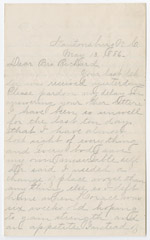 | Letter from Annie E. Snow to Richard Harvey Wright, May 13, 1886 Annie E. Snow gives a report to her brother-in-law Richard H. Wright about her health after the birth of her son, Horace Snow. Annie approves Richard's selection of the monument, inscription, and verse for the grave of Richard's deceased wife, Mamie Exum Wright. | |
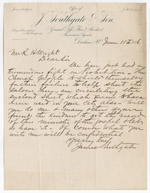 | Letter from James Southgate to Richard Harvey Wright, June 11, 1886 James Southgate asks Richard Harvey Wright for his support of Prohibition in Durham, North Carolina. | |
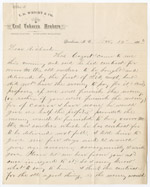 | Letter from Thomas D. Wright to Richard Harvey Wright, November 19, 1886 Thomas Wright seeks advice from his brother, Richard Harvey Wright, on a business proposal offered by Thomas Cozart. Mr. Cozart wants to buy and deliver 10000 lbs of "old smokers," but lacks cash. Cozart offers the Wright Brothers half of the profits if they will contribute cash. Thomas mentions a fire that burnt an entire block between Mangum and Church streets and nearly reached the Methodist church. | |
 | Letter from Thomas D. Wright to Richard Harvey Wright, February 07, 1887 Thomas shares family news. Nannie Wright will take Richard's daughter, Little May to visit with Annie Snow. Little May seems "bright and playful this morning." Thomas thanks his brother for sending medicines and notes that the current illness has left him confined to his bed. Thomas asks his brother for advice on purchasing real estate from Tilley. | |
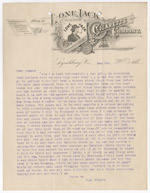 | Letter from Richard Harvey Wright to Thomas D. Wright, May 09, 1887 With anticipation of rising prices of tobacco cutters, Richard Wright advises his brother Thomas Wright to buy out Reed & McGees tobacco stock. In sharing family news, Richard writes that his daughter "Little May is I think improving." | |
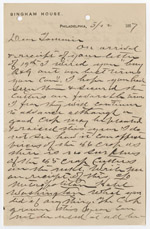 | Letter from Richard Harvey Wright to Thomas D. Wright, May 22, 1887 In this letter, Richard discusses the conditions of the tobacco crop and chastizes his brother for not heeding his previous advice to buy out "R & G on best terms you can." | |
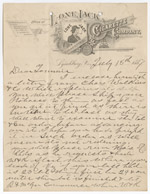 | Letter from Richard Harvey Wright to Thomas D. Wright, July 18, 1887 Writing on Lone Jack Cigarette Company stationary, Richard Harvey Wright directs his brother, Thomas, how to prize, package, and ship tobacco for the Charles Watkins & Company. | |
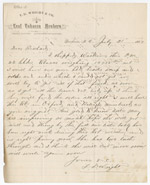 | Letter from Thomas D. Wright to Richard Harvey Wright, July 21, 1887 Thomas blends family and business news in this letter to his brother, Richard Harvey Wright. He has just shipped roughly 20,000 pounds of tobacco to one customer. He tells Richard that his daughter May is sick and expresses hope that she will feel well by fall. He describes his own daughter who had also been ill as plump and teething. | |
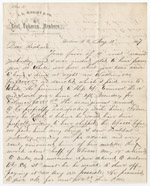 | Letter from Thomas D. Wright to Richard Harvey Wright, August 11, 1887 Thomas Wright highlights notable developments in the tobacco market; E. J. Parrish has announced his plans to rebuild his tobacco warehouse. Thomas also shares family news: Richard's daughter, Little May is improving. Thomas also comments on his own health. | |
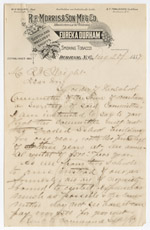 | Letter from S. F. Tomlinson to Richard Harvey Wright, August 20, 1887 In his role as secretary of the School Committee of the Town of Durham, S.F. Tomlinson writes Richard Wright about renting the "Graded School building" in Durham, North Carolina, for one year. Tomlinson requests that the contract start in September 1887 and be renewable for up to three years at $500 per year. | |
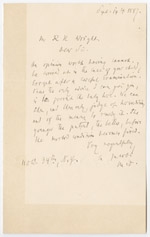 | Letter from A. Jacobi, M.D. to Richard Harvey Wright, September 14, 1887 Dr. A. Jacobi, a prominent New York pediatrician advises Richard Wright to bring Mamie, his ailing daughter, to New York for a diagnosis. | |
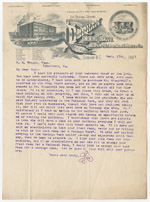 | Letter from Julian Shakespeare Carr to Richard Harvey Wright, September 17, 1887 Julian Shakepeare Carr informs Richard Harvey Wright about his plan to establish a national bank in Durham and inquires whether Wright can offer commercial space for the enterprise. | |
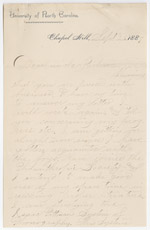 | Letter from McCord Wright Ball to Richard Harvey Wright, September 25, 1887 McCord Wright Ball describes his life as a student at the University of North Carolina. He reports that he joined the University's Philanthropic Society and is studying the Isaac Pitman system of phonography [e.g. shorthand]. | |
 | Letter from Thomas D. Wright to Richard Harvey Wright, September 29, 1887 Thomas D. Wright acknowledges a letter from his brother, Richard Harvey Wright. Thomas notes that public concerns about frost damage on tobacco plants in North Carolina seem unwarranted. He believes this is the best crop of tobacco since the Civil War. He discusses real estate developments and the cost of land being sold by Tilly near Alston Avenue. Thomas closes with an update on the construction of Richard's new home. | |
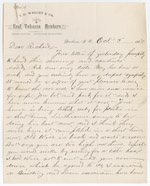 | Letter from Thomas D. Wright to Richard Harvey Wright, October 03, 1887 Thomas expresses concern for Richard's daughter, Little May, who is ill. He updates his brother on the work that Linthicum is doing to build a house for Richard Harvey Wright. He also notes that a new Building and Loan Association plans to build homes on property east of Alston Avenue. | |
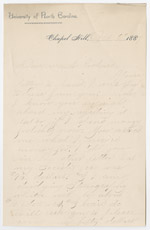 | Letter from McCord Wright Ball to Richard Harvey Wright, October 06, 1887 McCord Wright Ball (Class of 1891) requests $50.00 from his uncle Richard Harvey Wright for costs associated with his attendance at the University of North Carolina. McCord tries to justify his thrift by saying that he walked from Chapel Hill to Durham "to keep from paying a dollar round trip." | |
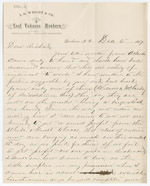 | Letter from Thomas D. Wright to Richard Harvey Wright, December 6, 1887 In this letter to his brother Richard, Thomas Wright, proprietor of the tobacco brokerage T. D. Wright and Company, shares the challenges which he faces in the tobacco market. He also notes that Mrs. Stokes lost both of her conjoined twins after their birth. | |
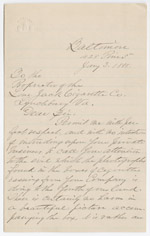 | Letter from John T. Wightman to Richard Harvey Wright, January 03, 1888 Baltimore clergyman, John T. Wightman, expresses his disapproval about the photographs packaged in cigarette boxes and the evil the cigarette cards are doing to youth. Wightman begs Richard Harvey Wright to end the packaging of "vile pictures" in Lone Jack cigarettes. | |
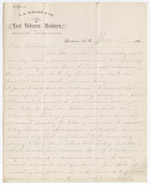 | Letter from Thomas D. Wright to Richard Harvey Wright, January 09, 1888 Thomas Wright has a gloomy outlook on his upcoming trip to Richmond in an effort to procure more tobacco. He thinks it's folly for a man to speculate in tobacco unless he has $25,000 in capital. He wants to try a different approach but needs advice and cash from his brother, Richard Harvey Wright. He asks Richard to consider helping him purchase land from Tilly. | |
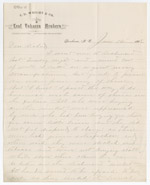 | Letter from Thomas D. Wright to Richard Harvey Wright, January 16, 1888 Thomas Wright tells his brother, Richard Harvey Wright, about his inability to sell his firm's tobacco in the Richmond market. Thomas observes that Durham-grown tobacco costs 25% more than the tobacco offered by Richmond tobacco brokers. | |
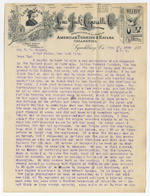 | Letter from A. T. Powell to Richard Harvey Wright, January 17, 1889 A. T. Powell, secretary and treasurer of the Lone Jack Cigarette Company in Durham, North Carolina, describes a gruesome industrial accident that caused the death of a child in the Lynchburg cigarette factory. He notes that the Coroner called the death accidental. | |
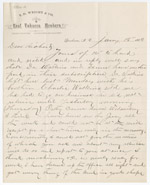 | Letter from Thomas D. Wright to Richard Harvey Wright, January 18, 1889 Thomas gives quick report of the Durham mill executives and their travels. He also reports that Richard's daughter Mamie (sometimes described as Little May) is recovering from mumps. | |
 | Letter from Richard Harvey Wright to George W. Moore, Jr., January 19, 1889 Richard Harvey Wright asks George Moore,Jr. to cease selling shares relating to his Bonsack machine enterprise. Wright explains "it is good stock & no machine yet made or under way can compete with it." | |
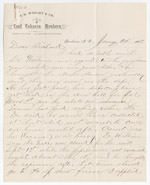 | Letter from Thomas D. Wright to Richard Harvey Wright, January 24, 1889 Thomas D. Wright updates his brother, Richard Harvey Wright, on Durham business news and the health of Mamie Richard's daughter. The child has just recovered from mumps. | |
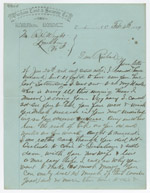 | Letter from Robert I. Rogers to Richard Harvey Wright, February 04, 1889 Robert I. Rogers, the secretary and treasurer of Durham Land and Security Company, Rogers tells Richard about real estate prices and agricultural news in Durham. | |
 | Letter from Thomas D. Wright to Richard Harvey Wright, March 20, 1889 Thomas D. Wright updates his brother, Richard Harvey Wright, Vice-President of Durham Bobbin and Shuttle Mill, on business affairs. Thomas comments that the Farmer's Alliance rented the old Reams warehouse and states that there may be a shoe factory in Durham. Eugene Morehead, a banker from Durham, died in Savannah, Georgia. | |
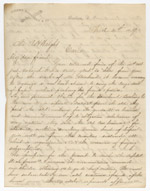 | Letter from W. M. Morgan to Richard Harvey Wright, April 04, 1889 William M. Morgan, who worked at the Eugene Morehead Bank, invites Richard Harvey Wright to join a new bank. He mentions the railroad and news about general store owner Atlas M. Rigsbee, John Markham, and tobacco dealers Stokes and Geer. | |
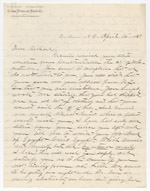 | Letter from Thomas D. Wright to Richard Harvey Wright, April 16, 1889 Thomas Wright reports on the fiscal situation of the Durham Bobbin & Shuttle Mills Co.:" Expenses up to this time are greatly in excess of out put [sic] of work." He also notes that Dr. Carr is treating Richard's daughter Little May with electricity. | |
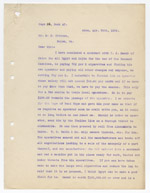 | Letter from Richard Harvey Wright to D.B. Strouse, April 19, 1889 Richard Harvey Wright sends a report to D. B. Strouse, President of the Bonsack Machine Company in which he describes his recent conversations with E. J. Manuk, a British subject and tobacco merchant living in Egypt. Wright explains the terms of the contract that will enable Manuk to use the Bonsack machine for cigarette production. | |
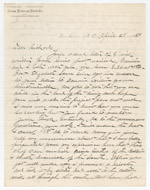 | Letter from Thomas D. Wright to Richard Harvey Wright, April 29, 1889 Thomas Wright shares a detailed report of the Durham Bobbin & Shuttle Mills's accounts and operations with his brother Richard Wright. | |
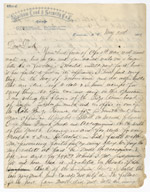 | Letter from Robert I. Rogers to Richard Harvey Wright, May 23, 1889 Robert I. Rogers, secretary of the Durham Land & Security Co. writes Richard Harvey Wright about economic news in Durham. He reports on a legal dispute over rent with "our man French." He closes by encouraging Wright to start a cotton factory. | |
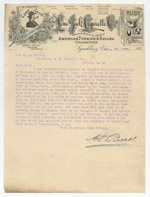 | Letter from A. T. Powell to Richard Harvey Wright, August 26, 1889 A. T. Powell, secretary and treasurer of the Lone Jack Cigarette Company in Lynchburg, Virginia sends sympathies to Richard Harvey Wright for Little May's death and confides that he also buried his first born. | |
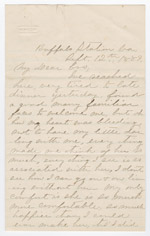 | Letter from Nannie Wright to Richard Harvey Wright, September 12, 1889 Writing from Buffalo Station, Virginia, Nannie Wright describes her feelings of loss to her brother Richard Harvey Wright as she mourns the loss of her niece, Richard's daughter, "Little May. | |
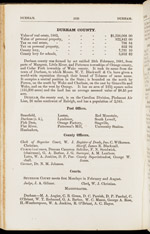 | North Carolina state directory and gazetteer, 1883-84 (Excerpt) Section of Chataigne's 1883-1884 gazetteer listing the names of merchants, business owners, and tradesmen in Durham County, categorized by occupation. The directory also provides information about public officials and the location of post offices. | |
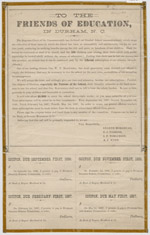 | To the friends of education in Durham, North Carolina The Durham Graded School Committee designed this circular to raise money for the support of Durham's graded school in the 1886-1887 school year. Eugene Morehead, R. F. Webb, Edward James Parrish, and Samuel F. Tomlinson served on the committee which sought funding for the school. | |
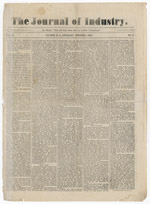 | Oration on the occasion of the Second Annual Exposition of the Colored People of North Carolina, delivered on October 1, 1880 Frederick Douglass delivered this “Oration on the occasion of the Second Annual Exposition of the Colored People of North Carolina” in Raleigh, North Carolina on October 1, 1880. Douglass offered his vision of economic progress for black farmers living in the South. Charles Hunter, editor of the Journal of Industry reprinted the oration in his newspaper and included other news stories about the Exposition. | |
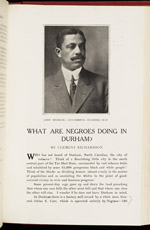 | What are Negroes doing in Durham? Essay by Clement Richardson in the Southern Workman highlighting the achievements of the African American community in Durham in the early 1910s. Richardson focuses on the contributions of black entrepreneurs and professionals including E. R. Merrick, Robert Fitzgerald, Stuart Lynn Warren, John Merrick, Dr. A. M. (Aaron McDuffie), R. H. Clegg, W. G. Pearson, J. S. Scarborough, E. W. Cannady, Dr. F. D. Page, Peyton H. Smith, P. W. Dawkins, Jr. and others. | |
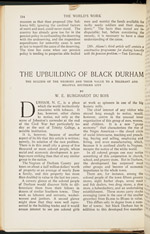 | Upbuilding of black Durham: the success of the Negroes and their value to a tolerant and helpful southern city Essay by W. E. B. DuBois in the World's Work reporting on his visit to Durham, North Carolina in 1912. DuBois analyzes the economic culture and explores the history of race relations in this southern city. DuBois provides a history of black enterprises and educational institutions that served the black community in Durham. The article features photographs of R.B. Fitzgerald, C.C. Spaulding, White Rock Baptist Church, North Carolina Mutual Insurance Company and a view of workers in a black-owned hosiery manufacturing company. | |
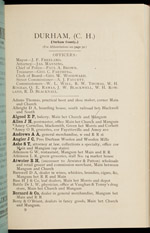 | Chas. Emerson’s North Carolina tobacco belt directory 1886 (Excerpt) This section of Emerson's 1886 directory lists businesses within the corporate limits of the town of Durham.The directory lists the names of proprietors, stores' locations and the products sold. Individuals with African American heritage are denoted by an asterisk (*). | |
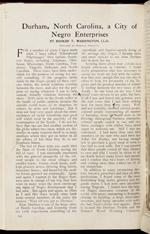 | Durham, North Carolina, a city of Negro enterprises Booker T. Washington, principal of Tuskegee Institute, penned this essay in 1911 for the illustrated magazine, Independent. Washington, recounts his travels to Durham and gives his observations about race relations in Durham. Washington discusses the economic and cultural contributions of many prominent members of the African American community including: Richard B. Fitzgerald, Aaron M. Moore, Richard E. Clegg, John Merrick, and Charles Clinton Spaulding. He devotes much of his analysis to the economic development of the black community in a place that he dubbed, “City of Negro Enterprises.” | |
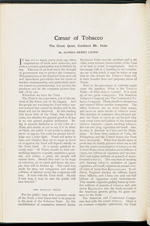 | Caesar of tobacco : the great, quiet, confident Mr. Duke Biographical portrait of James Buchanan Duke, with a focus on his leadership role in the American Tobacco Company and the Continental Tobacco Company. | |
 | Chas. Emerson’s North Carolina tobacco belt directory 1886 (Excerpt) This excerpt from the 1886 directory lists Durham County's land owners. Each entry includes the landowner's name, the location of the nearest post office, and the number of acres the individual owned. Individuals with African American heritage are denoted by an asterisk (*). The directory identifies 16 post offices in Chapel Hill, Dayton, Durham, Fish Dam, Flat River, Hillsboro, Kunkadora, Luster, Lyndover, McCown, Morrisville, Mount Tirzah, Orange Factory, Red Mountain, Staggville, and South Lowel. Advertisers include John L. Markham; Robertson, Lloyd and Co.; and the Durham Recorder. | |
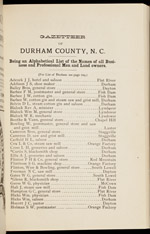 | Chas. Emerson’s North Carolina tobacco belt directory 1886 (Excerpt) This section of the 1886 directory entitled, Gazetteer of Durham County, North Carolina, lists 70 Durham County merchants and land owners, together with the name of the post office located nearest their businesses. Individuals with African American heritage are denoted by an asterisk (*). Occupations include hotel and saloon keeper, shoe maker, general store keeper and grocer, postmaster, mechanic and blacksmith, minister and pastor, saw and grist mill owner, physician, and cotton ginner. | |
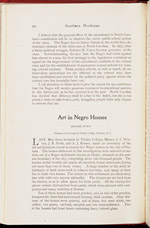 | Art in Negro homes Essay by Trinity College professor Jerome Dowd (1864-1952) describing a survey made by three Trinity College students in the early 1900s of the interiors and exteriors of 25 homes in Hayti, a largely African American community in Durham, North Carolina. The article enumerates the material cultural artifacts--decorative art, carpets, and furnishings--in these homes as well as the titles of books, magazines and newspapers. | |
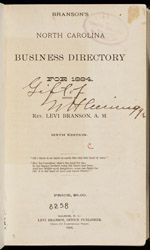 | Branson's North Carolina business guide This section of the guide contains physical attributes, land values, livestock values, taxes, and population statistics for Durham County. Branson notes that Durham County's population was 13,000, of which 8,500 were white and 4,500 were black. Also provided are the towns that had a post office, as well as county officers, court hearings, townships, magistrates, churches, pastors, and denominations. For individuals, Branson lists the name, nearest post office, and occupation. Edward James Parrish and Blackwell's Warehouse bought advertising space in the guide. | |
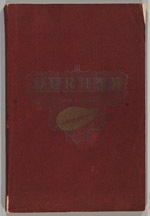 | Hand-book of Durham, North Carolina : a brief and accurate description of a prosperous and growing southern manufacturing town This pocket-sized handbook documents the people, businesses, social conditions, and government of Durham, North Carolina, and compares Durham's industrial and social advantages to other cities of the same size. It includes statistical records and information about Durham's government, health, real estate, taxes, buildings, streets, waterworks, fire departments, electric lights and gas, telephones, hotels, hospitals, markets, schools and colleges, churches, lodges, and social clubs. Included are lithographs of Mangum Street and Main Street and depictions of prominent buildings, such as: Bennett Place; Durham County Court House; the Fire House; Hotel Carolina; City Hospital; Durham Graded School; Trinity College's Main Building; Trinity Methodist Church; Main Street Methodist Church; the Presbyterian Church; the First and Second Baptist Church; bank buildings; the factory of the Blackwell Durham Tobacco Co.; Duke Tobacco Factory; and textile factories. Portraits include Isaac N. Link, ma... | |
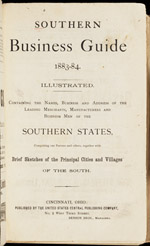 | Southern business guide, Section of the 1883-84 Southern Business Guide containing the personal names, business names, and street addresses of the leading merchants, manufacturers, and businessmen of Durham, North Carolina. Also provides a summary of Durham's history and railroad lines. The guide lists 71 businesses and their locations. | |
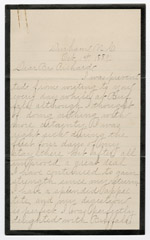 | Letter from Annie E. Snow to Richard Harvey Wright, October 01, 1889 Annie E. Snow shares family news with her brother-in-law Richard H. Wright. She also describes her meeting with the Methodist preacher Sam Jones, William T. Blackwell's bankruptcy and Julian S. Carr's travels. | |
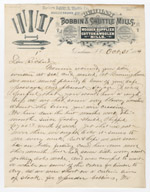 | Letter from Thomas D. Wright to Richard Harvey Wright, October 31, 1889 Thomas D. Wright shares details of the Durham Bobbin and Shuttle Mill's sales report and the condition of its 40 employees. He refers to Tom Jones's death, to religion, and to a visit from Methodist preacher Sam Jones. | |
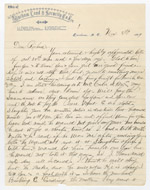 | Letter from Robert I. Rogers to Richard Harvey Wright, November 08, 1889 Robert I. Rogers shares news about real estate in Durham, the rise in tobacco prices and the upcoming meeting of Blackwell's creditors. He also comments on the smaller turn out for the evangelical preacher Sam Jones, who held his revival in Durham. | |
 | Letter from McCord Wright Ball to Richard Harvey Wright, November 10, 1889 McCord Wright Ball tells his uncle, Richard Harvey Wright, about Methodist preacher Sam Jones, his money problems, and his medical expenses. | |
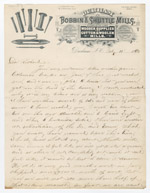 | Letter from Thomas D. Wright to Richard Harvey Wright, February 11, 1890 Thomas Wright shares tobacco market news with his brother, Richard Harvey Wright. He notes that conditions are not favorable for buying tobacco on speculation as tobacco prices are "very high." Thomas also shares his plan for buying land from "old man Tilley" to make a new home for his family. | |
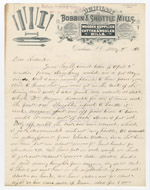 | Letter from Thomas D. Wright to Richard Harvey Wright, May 09, 1890 Thomas D. Wright acknowledges receiving Richard's letter from Hong Kong. He sends a detailed report about the fiscal situation at the Durham Bobbin and Shuttle Mill. He notes also that "Trinity College will be moved to Durham. Will locate the college, in Blackwell's Park, arrangements are now being made to commence building. Most people think Durham is on the eave of a big boom." | |
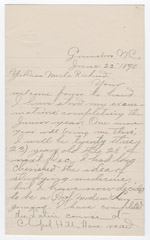 | Letter from McCord Wright Ball to Richard Harvey Wright, June 22, 1890 McCord Wright Ball (Class of 1891) sends academic news to his uncle Richard Harvey Wright including information about the curriculum in his French and German classes. He also includes a list of the authors that he has read in his Latin classes. He closes the letter by sharing his aspirations to become a professor of modern languages. | |
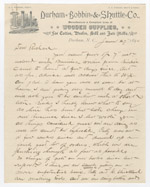 | Letter from Thomas D. Wright to Richard Harvey Wright, June 27, 1890 Thomas D. Wright, updates his brother, Richard Harvey Wright, on the fiscal situation at the Durham Bobbin and Shuttle Company. He also describes the emergence of new business ventures in Durham--The Farmers' Alliance tobacco plug factory and general excitement about a possible future cotton factory. | |
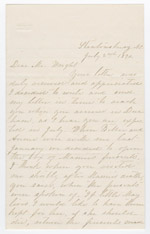 | Letter from Mrs. W. J. Exum to Richard Harvey Wright, July 02, 1890 After losing his wife Mamie in childbirth, Richard Harvey Wright asked Mamie's relatives to convey the presents that the couple received to his daughter Little May.In the event of his daughter's death Richard stipulated that his wife's family return presents given by his friends and family. | |
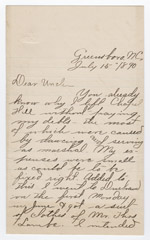 | Letter from McCord Wright Ball to Richard Harvey Wright, July 15, 1890 McCord Wright Ball (Class of 1891) updates his uncle Richard Harvey Wright on his social life at the University of North Carolina and defends his spending habits. The letter includes a detailed listing of costs associated with dance lessons and German language instruction. | |
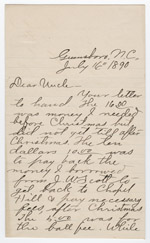 | Letter from McCord Wright Ball to Richard Harvey Wright, July 16, 1890 In this letter to his uncle, McCord Wright Ball details some of his recent expenses associated with college life. He also discusses the medical remedies he purchased in an effort to recover from a bout of "grippe." | |
 | Letter from Thomas D. Wright to Richard Harvey Wright, July 24, 1890 Thomas Wright explains that the presents of silver have been sent to Mrs. Annie E. Snow and she is expected to forward to Mrs. Edmundson.He also discusses orders at the Durham Bobbin and Shuttle Co. | |
 | Letter from Robert I. Rogers to Richard Harvey Wright, July 26, 1890 Robert Rogers, secretary and treasurer for Durham Land and Security, writes to Richard Harvey Wright about the renewal of the graded school contracts. He states that William Guthrie authorized the contract. | |
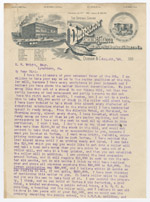 | Letter from Julian S. Carr to Richard Harvey Wright, August 06, 1890 Julian S. Carr, President of Durham Smoking Tobacco and Blackwell's Durham Tobacco Co., gives Richard Harvey Wright his vision to develop Durham and make more money. | |
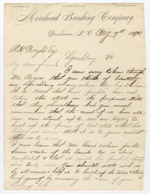 | Letter from William M. Morgan to Richard Harvey Wright, August 07, 1890 William M. Morgan expresses disappointment in Richard Harvey Wright's plans to settle in Lynchburg, Virginia, rather than Durham, North Carolina. In discussing the local economy, Morgan mentions Julian S. Carr's real estate scheme. | |
 | Letter from Charles M. Glenn to Richard Harvey Wright, August 13, 1890 Charles M. Glenn, a Greensboro pharmacist from Tate Brothers Wholesale Druggists, advises Richard Wright to take his ailing brother Thomas Wright to Buffalo Springs, Virginia where he could find a cure for his Gastro-Duodenal Catarrh or gall stones. | |
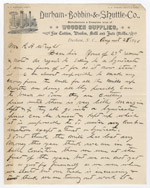 | Letter from Jacob L. Watkins to Richard Harvey Wright, August 28, 1890 Jacob Lawrence Watkins, President of Durham Bobbin and Shuttle Mill, responds to Richard Harvey Wright's letter inquiring about the selling of the company to a syndicate. Watkins believes that a trust or syndicate could benefit his business. | |
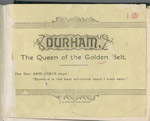 | Durham, the queen of the golden belt An pamphlet created by Durham Consolidated Land and Improvement Company to promote investment in businesses and real estate in Durham, North Carolina. Includes three lithographs of buildings in Durham: Main Building at Trinity College; West End Cotton Factory; and Wescarr Knitting Mill. Durham is described as a sophisticated town with well-developed industrial, commercial, and residential districts for: plants, mills, factories, railroad stations and tracks, banking facilities, schools, churches, and colleges. | |
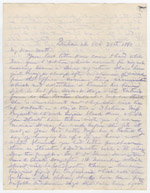 | Letter from James Southgate to Mattie Logan Southgate, October 28, 1881 James Southgate details his visit to the Yorktown Centennial and his shopping expedition in Richmond to his daughter, Mattie Southgate, who attends boarding school in Staunton, Virginia. In relating news from Durham, James describes his daughter Annie Southgate's recovery from typhoid fever, provides details of Mollie Day's failed courtship, preparations for the Methodist Church Conference and news about Durham neighbors and family. James Southgate also inquires of Mattie's schooling, her teacher, Lizzie Daniels, and advises her to strive for excellence, especially in her penmanship. | |
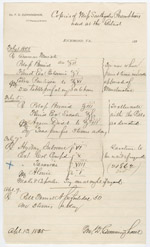 | Copy of Prescriptions used by Miss Annie Southgate at the Retreat of the Sick, Richmond, Virginia, April 13, 1885 Medications prescribed by Frank D. Cunningham for his patient Annie Southgate while she visited the Retreat of the Sick in Richmond, Virginia. Dr. Cunningham advised Annie to use two of the remedies at the "approach of menstruation." | |
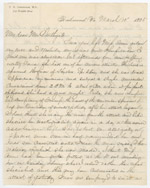 | Letter from F. D. Cunningham, M.D. to James Southgate, March 10, 1885 Dr. Frank. D. Cunningham, director of the Retreat of the Sick, Richmond, Virginia. writes James Southgate with a description of his daughter's condition. The physician refers to Annie Southgate's "nervous attacks" and terms her condition Hyster Epilepsy. | |
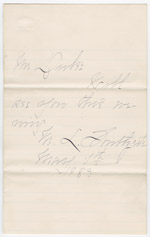 | Letter from Mattie Logan Southgate to James Buchanan Duke, May 05, 1883 Mattie Southgate replies with an affirmative response to James Buchanan Duke's request to call on her. | |
 | Letter from James Buchanan Duke to Mattie Logan Southgate, May 07, 1883 James Buchanan Duke makes a formal request to call on Mattie Southgate. | |
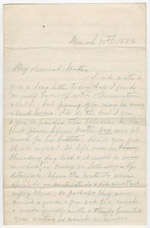 | Letter from Delia H. Southgate to Mattie Logan Southgate, March 15, 1882 Delia H. Southgate shares news with her daughter Mattie about the poor health of Sarah Raboteau ( Aunt Sarah), Annie Southgate as well as herself. She reports that their family's church will install a bell, notes that the revivals have closed, and gives Mattie news of Lula Freeland's school. Delia inquires about the care package that she sent Mattie and asks for details about the soiree held by the Wesleyan Female Institute. | |
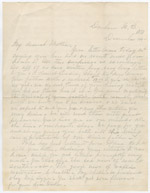 | Letter from Delia H. Southgate to Mattie Logan Southgate, December 14, 1881 Delia H. Southgate shares news from Durham with her daughter Mattie Southgate who attends the Wesleyan Female Institute. Charlie Soong and Mr. Vaughn have been courting Mattie's sister, Annie. Delia describes her husband James Southgate's health problems, her daughter Lessie's adventures in Texas and her son Jimmie's travel to the seashore. She also inquires whether Mattie received gifts of clothing and money that she sent and promises to ship another box for Christmas. | |
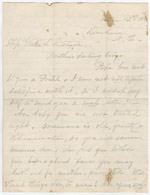 | Letter from Delia H. Southgate to Mattie Logan Southgate, December 12, 1881 Delia H. Southgate shares news from home with her daughter Mattie Logan Southgate. Mattie's friend Willy Wilkinson battles a fever, her sister Annie has rebounded from illness, her brother Jimmie has traveled to Beaufort for fishing while Aunt Sarah plans a trip to Henderson. She inquires about the items Mattie will need for winter at the Wesleyan Female Institute and promises to send a box or care package for Christmas. Delia asks Mattie for information about her studies in vocal and instrumental music with Miss Lizzie Daniels and Professor E. Louis Ide. | |
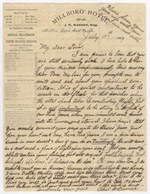 | Letter from Charles Conrad to Thomas Decatur Jones, July 11, 1889 Charles Conrad writes about his concern for Thomas Decatur Jones's spiritual condition should Thomas die from his illness. Conrad reflects on Heaven and the fact that his parents, wife, and two children are waiting for him there. | |
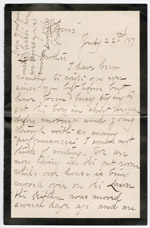 | Letter from Mattie Logan Southgate Jones to Delia H. Southgate, July 22, 1887 Mattie Southgate Jones writes her mother Delia Haywood Southgate who is visiting her relations in Asheville, North Carolina. Mattie's home is being moved across her lot, while her six-month old baby, Thomas Decatur Jones is teething and recovering from a fever. Mattie sends news of her father, James Southgate, who is in Saratoga Springs and her husband, "Tomie." She concludes her letter with regards for her cousins Lawrence Pulliam and his wife Kate Furman Pulliam and Eva Thomas Furman Brown and her husband Edwin Brown. | |
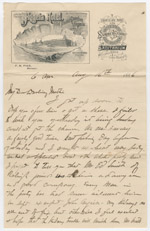 | Letter from Thomas Decatur Jones to Mattie Logan Southgate Jones, August 16, 1886 In this letter, from Thomas Decatur Jones to, his wife, Mattie Logan Southgate Jones, Thomas gives news about his friends from Durham who traveled to the Hygeia Hotel, a sanatarium on the Virginia's coast to recuperate and fish. Thomas says all his friends except for John Angier has had some sort of ailment. Thomas's kidneys bothered him. Mr. Watts departed early to return with his father to Durham due to an illness. After Mr. Watts left, Thomas and his friends could not decide what route to return by to Durham. Some people wanted to travel along the Virginia coastline past Nag's Head, North Carolina, and then west to Durham. B Thomas wanted to return to Durham via Richmond, Virginia or further west through Asheville, North Carolina and then head south or west to Durham. Mr. Morehead says he must get home to Durham, North Carolina, by the next day. Thomas is upset he did not find Mattie in his bed at night. The letter is written on stationary with an engraved image of Hygeia Hot... | |
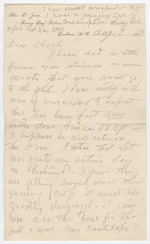 | Letter from Thomas Decatur Jones to Charlie ____, August 03, 1889 In a letter to Charlie _______, Thomas Decatur Jones complains that the heavy rains have ruined his garden crop and adversely affected the Richmond tobacco market. He describes his medical condition and the treatment prescribed by Dr. A. G. Carr which left him "almost paralyzed." This letter is written on Fancy Leaf Tobacco stationery. | |
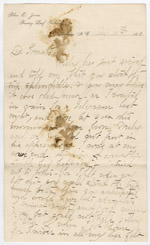 | Letter from Mattie Logan Southgate Jones to Thomas Decatur Jones, August 10, 1889 Mattie Southgate Jones writes her husband Thomas Decatur Jones conveying her happiness that he arrived at his destination safely. She reports that their son Decatur slept fitfully and continues to talk "insesently" about his absent father. She details her domestic chores and forwards news from A.S. DeVlarming, her husband's bookkeeper, about the Jones tobacco enterprise. She notes that the local newspaper, the Sun, published a lengthy personal about Thomas. She closes with a request that Thomas send news through his correspondence. | |
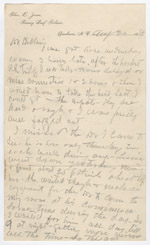 | Letter from Thomas Decatur Jones to A. S. DeVlarming, August 30, 1889 In a letter to his colleague A. S. DeVlarming, Thomas Decatur Jones describes a difficult railroad journey to New York City and his lengthy search for a medical specialist who could treat his ailments. Thomas notes the help his sister Lessie Southgate provides him in locating a physician. The new doctor terms his condition "lung disease." Thomas Jones penned the letter on Fancy Leaf Tobacco stationery. | |
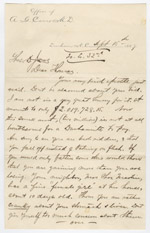 | Letter from A. G. Carr, M. D. to Thomas Decatur Jones, September 15, 1889 Dr. A. G. Carr pens this darkly humorous letter to his friend and patient, Thomas Decatur Jones (1852-1889). He tells Thomas that his outstanding medical bill totals two million dollars and that he would like Thomas to will him his infant son Decator, should the elder Jones, or his wife, die. Carr describes the excitement in Durham over the anticipated arrival of Sam Jones, the revivalist, and the death in Goldsboro of Dr. William M. Robey, a Methodist clergyman. He comments on the general health of Durham's citizens and writes that he will soon assist Mrs. Charlie McGary through childbirth. He closes by noting the birth of a daughter to Mrs. Thomas Martin and a raucous fox and oppossum hunt. | |
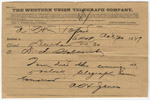 | Telegram, October 30, 1889 A Western Union Telegraph Co. telegram sent to D.J. Holcombe of Danville, Virginia reports the death of Thomas Decatur Jones (1852-1889). | |
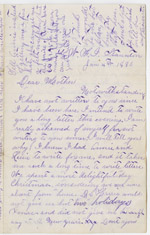 | Letter from Mattie Logan Southgate to Delia H. Southgate, January 04, 1880 Mattie Southgate writes her mother Delia Haywood Wynne Southgate with news from her boarding school, Wesleyan Female Institute. Mattie celebrated Christmas with her sisters Annie Moore Southgate and Lessie Muse Southgate during the two-day school holiday provided by principal William A. Harris. The girls send their mother bills for instruction with their music teachers Lizzie Daniels, Anna Boyd and Professor Ide. In addition, they report that they must purchase more sheet music for their lessons, because their music is "out of style." Mattie provides news of an upcoming school performance and a defense of her progress in Miss Williams' history class. She closes with a request that her mother send a box with "cocoanut cake," preserves, mince pies, nuts, and ground peas. | |
 | Letter from N. O. Wilkinson to Mattie Logan Southgate, January 27, 1880 N. O. Wilkinson sends this letter to her young neighbor Mattie Logan Southgate, a student at the Wesleyan Female Institute in Staunton, Virginia. Mrs. Wilkinson sends news about her children, Willie, Minnie, and Tommie. Mattie's sister, Annie Southgate spent the day with Mrs. Wilkinson's daughter, Willie. N. O. Wilkinson reports the activities of Durham's young people over Christmas and notes the construction activity in town. She mentions her son's recent hunting trip and reminisces about her school days at Greensboro College. Mrs. Wilkinson closes with a request that Mattie's sister Lessie send her news from school. | |
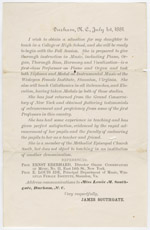 | Broadside from James Southgate, July 01, 1881 In an effort to help his daughter obtain a teaching position, James Southgate distributes a broadside describing Lessie Muse Southgate's qualifications in vocal and instrumental music. The broadside gives an overview of Lessie's education at the Wesleyan Female Institute in Staunton, Virginia and the Grand Conservatory of Music in New York. Mr. Southgate gives Professor Ernst Eberhard of the Grand Conservatory and E. Louis Ide of the Wesleyan Female Institute as references. The broadside notes that Lessie is a member of the Methodist Episcopal Church, but is willing to work as music instructor for any denomination. | |
 | Letter from James Haywood Southgate to Mattie Logan Southgate, November 20, 1881 James Haywood Southgate writes his sister Mattie Logan Southgate with news from home and advice for her studies at Wesleyan Female Institute James commends Mattie on the progress she made in her report card grades and counsels his sister on how to build a "superior intellectual edifice." He advises that she use her letter writing to "improve her mode of expression" and suggests that she abandon her habitual practice of underlining. James thanks for Mattie for sending a photograph. He details the foods that the Southgate family has brought to their Durham home in order to host visitors for the Methodist Episcopal Church, South's North Carolina Annual Conference. He describes his plans to travel to Atlanta for the Exhibition and notes that he may visit his Uncle Thomas Wynne and his family in Columbus, Georgia. He closes by inquiring after a parcel he sent Mattie. James writes his letter on stationery from the Office of James Southgate, General, Fire, Insurance and Commission Agent. | |
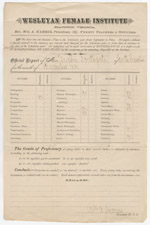 | Mattie's Report Card from Wesleyan Female Institute, December 1881 This December 1881 report card from the Wesleyan Female Institute at Staunton, Virginia assesses Mattie Southgate's progress in writing, natural philosophy, rhetoric, elocution, French, German, vocal music, instrumental music, calisthenics, and conduct. Directed by principal William A. Harris, the Wesleyan Female Institute offered a range of courses including those on Butler's Analogy, evidence of Christianity, Geometry -- plane and analytical, philosophy, mental and moral, and book keeping. | |
 | Letter from James Southgate to Mattie Logan Southgate, December 03, 1881 James Southgate sends his daughter, Mattie Logan Southgate spending money so that she can pay her bills and purchase winter flannel. He plans to have C. B. Green and G. E. Webb forward Durham's main newspapers--the Daily Tobacco Plant and Durham Recorder-- so that she might read about the proceedings of the North Carolina Annual Conference of the Methodist Episcopal Church, South's Annual Conference . The Southgate family hosts a number of Conference attendees who travel to Durham for the event. This letter is written on stationery from the Office of James Southgate, General, Fire, Insurance an Commission Agent. | |
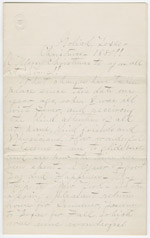 | Letter from Lessie Southgate to James Southgate, Delia Southgate, James Haywood Southgate, Annie Southgate, Mattie Southgate, December 25, 1881 Lessie Southgate writes her family in Durham from Goliad, Texas where she is teaching music. She vividly recollects her illness and recovery in the winter of 1880, the visits of doctors Carr, Battle, and Knox, as well as the rich "Christmas eatings," her spare diet of "tea-eggs, toast and mush" and the gifts of her family and friends. Lessie tells her family about the benefit concerts she has organized and gives news of a concert she will give in Victoria, Texas. She writes about a fashionable dress that she will wear at Annie Bradshaw's wedding, a garment that she purchased with her earnings. | |
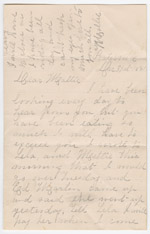 | Letter from Mollie Page to Mattie Logan Southgate, December 31, 1881 Mollie Page, school friend from Wesleyan Female Institute, writes Mattie about the festivities surrounding Christmas at her home in Batesville, Virginia. She attends a series of parties and writes of her conversation with Ed Martin and her correspondence with Leland Sneed (Lela) and Mettie Ricketts, fellow W. F. I. students. | |
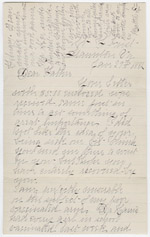 | Letter from Mattie Logan Southgate to James Southgate, January 29, 1882 Mattie Logan Southgate acknowledges receipt of five dollars from her father, James Southgate. She shares news from Cordelia Hunter Southgate (Aunt Hunter) and tells of writing her sister, Lessie. She has lots of news to report from the Wesleyan Female Institute. The principal, William A. Harris had each student immunized and Mattie jokes that "her scab will vaccinate most all of Durham." She comments on her grades and compares her progress in penmanship to that of her friend Leland Sneed. In closing, she requests more money to pay for additional practice time on the piano. The session with Professor Ide, she claims, is insufficient. | |
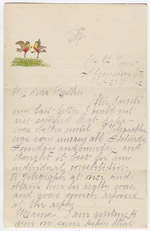 | Letter from Mattie Logan Southgate to Delia H. Southgate, February 27, 1882 Mattie Logan Southgate explains her concern for her father's health and the rationale behind her telegraphing home for news of his condition. The stationery is embellished with hand-drawn birds modeled on those drawn by her friend Minnie. Mattie asks her mother to send a box of water colors from Dike's book shop in Durham, so she can study art on her own. She describes the dress she will wear at the upcoming soiree at Wesleyan Female Institute and closes with a promise to write her sister Lessie. | |
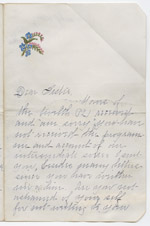 | Letter from Mattie Logan Southgate to Celestia Muse Southgate, March 26, 1882 Mattie Logan Southgate writes her sister Lessie (Celestia Muse) Southgate with news of festive and somber events at the Wesleyan Female Institute. She provides a vivid description of Alma Ivey's death from "tiphoid and brain fever," the visit of Alma's mother to school, and the funeral procession from school to the railroad depot. Mattie tells Lessie about her new interest in drawing and her lessons with Reverend Harris' daughter, Mattie. She discusses her coursework with Lizzie Daniels in vocal music and her plans to study art and musical elocution in the next year. Mattie notes that she visited Edmund Berkeley's studio and she promises to send her sister a photograph. | |
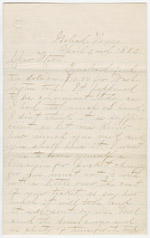 | Letter from Lessie Muse Southgate to Mattie Logan Southgate, April 02, 1882 Lessie Muse Southgate sends her sister Mattie Logan Southgate $10 for a train trip to Washington, D.C. from Staunton, Virginia. She also promises to send a dress in time for the trip. Lessie Southgate notes that Ida Seate, an alumnae of Wesleyan Female Institute (class of 1879), lives in Goliad, Texas at the same boarding house where Lessie resides. | |
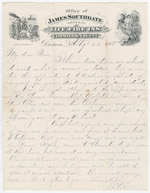 | Letter from James Haywood Southgate to Mattie Logan Southgate, April 06, 1882 James Haywood Southgate sends his sister Mattie Logan Southgate a humorous letter and photograph. James provides an immodest analysis of his physical features by comparing them with those of nineteenth-century luminaries. "You will doubtless note the appearance of that Classic brow, that Websterian mouth, that Clay cut ear, that Calhoun nasal organ . . . ." He commends Mattie on her academic progress at the Wesleyan Female Institute, particularly her improvement in painting, and offers that he might be able to visit her in Staunton, Virginia. | |
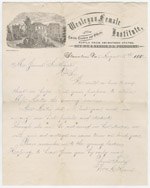 | Letter from William A. Harris to James Southgate, August 19, 1882 Reverend. William A. Harris invites James Southgate to re-enroll his daughter at the Wesleyan Female Institute for the fall 1882 session. The engraved letterhead depicts the school and grounds. | |
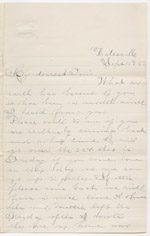 | Letter from Mollie Page to Mattie Logan Southgate, September 12, 1882 Under her nickname, "Mary Eddie," Mollie Page writes her school friend, Mattie Logan Southgate "Tom" to ask if she will come back to school. Mollie has planned to room with Mattie at the Wesleyan Female Institute. Mollie sends news of Leland Sneed and Mettie Ricketts and some other friends. | |
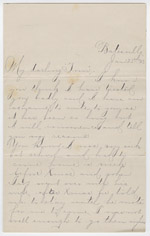 | Letter from Mollie Page to Mattie Logan Southgate, January 23, 1883 Mollie Page writes her friend Mattie Logan Southgate about an outbreak of scarlet fever at the Wesleyan Female Institute. After the principal William A. Harris informs his students of the disease, the young women flee school. Mollie describes the mass exodus of the girls as they sought refuge with their friends, relatives, and in the hotels in Charlottesville and Richmond, Virginia. Mollie reports that their friends Pattie, Cora, Cherry, Dean, and Eddie are safe but the fever took the life of Nannie Jordan. She relates her own story of illness while at the Wesleyan Female Institute, the visit of Dr. Henkle, and her subsequent recovery from dropsy at her home in Batesville, Virginia. | |
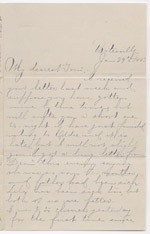 | Letter from Mollie Page to Mattie Logan Southgate, January 29, 1883 Writing under her nickname "Mary Eddie," Mollie Page sends her friend Mattie Logan Southgate ("Tom") news about principal William A. Harris' plan for resuming classes at the Wesleyan Female Institute. Mollie reports that Dr. Harris sent her father a letter with his proposal to start school in February, but she doubts that she will be able to attend. Mollie tells Mattie of her plans to travel to Charlottesville with her father and promises to send a photograph of herself. She shares news of their friends Lela, "Dean," Pattie, Cherry and her brother Bob. Mollie closes with a discussion of men, marriage, and tobacco. | |
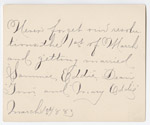 | Resolution, March 01, 1883 Wesleyan Female Institute schoolmates Leland Sneed ("Sammie Eddie"), Mettie Ricketts ("Dean"), Mattie Southgate ("Tom"), and Mollie Page ("Mary Eddie") pledge to never forget their "resolutions the 1st of March and getting married." The resolution appears to have been penned by Mollie Page. | |
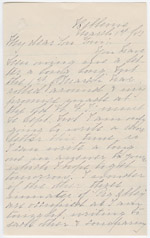 | Letter from Leland Sneed to Mattie Logan Southgate, March 01 1883 Leland Sneed, whose nickname is "Sammie Eddie," writes her school friend Mattie Southgate ( "Son Tom" ) about her recent birthday party. Leland mentions the gifts from her parents, particularly the bracelets she received from her father. She refers to the March 1st resolution to which she and her Wesleyan Female Institute school friends, Mettie Ricketts, Mattie Southgate, and Mollie Page, subscribed. | |
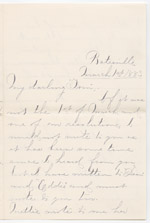 | Letter from Mollie Page to Mattie Logan Southgate, March 01, 1883 Mollie Page reminisces about her school days with Mattie Southgate at the Wesleyan Female Institute. She notes that school is in session and reports that the fever is still raging. Her father, she reports, "thinks the people are crazy to send their daughters back." Mollie refers to the March 1st Resolution and the pledge to correspond with her school friends. She tells Mattie that she has already written their friends "Dean" and "Eddie" and that she expects to receive a letter from Mattie. Mollie tells Mattie about social events in Batesville, complains that she missed Lela's birthday celebration, and notes that she will turn eighteen later in the month. | |
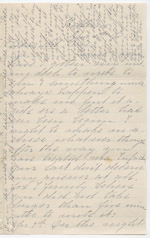 | Letter from Leland Sneed to Mattie Logan Southgate, April 04, 1883 Writing under her nickname "S. Eddie," Leland Sneed sends news to her friend Mattie Southgate ("Old Tom') about the parties and dances that she attends near her home in Bellevue, Virginia. She tells Mattie about the boys--Will Page, Jim White, and Steve Carpenter-- who traveled from Red Hill for the dances and reports on Mettie Rickett's courting. Leland reveals that she and her friend Byrdie Townley spied on Mettie and her beaux. In response to the eavesdropping, the courting couple whipped their friends with a cowhide. | |
 | Letter from James Southgate to Delia H. Southgate, Annie Moore Southgate, Mattie Logan Southgate, Celestia Muse Southgate, and Sallie Raboteau, September 07, 1883 James Southgate, together with his son James H. Southgate, sends news to his Durham household from Richmond, Virginia where the elder Southgate seeks medical care for his ailments. James describes the visits with friends, and the medical treatment he is receiving from his physician. James H. Southgate closes the letter with a postscript that describes the "Retreat for the Sick" and its costs. This letter was written on J. Southgate and Son, General Life, Fire, and Accident Insurance Agents stationery. | |
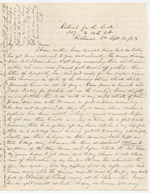 | Letter from James Southgate to Delia H. Southgate, September 12, 1883 James Southgate sends news to his wife, Delia H. Southgate, from the "Retreat for the Sick" in Richmond, Virginia. James describes the medicines--Blue Mass, Chlorate of Potash and calomel--that he has taken for his ailments and the effects these have had on his mouth and stomach. He notes the prices of fruits in the Richmond market, visits from the Mohsberg family, and advises Delia to make arrangements in Chapel Hill and Hillsboro to purchase peaches and pears for canning. Southgate asks for news about Mattie who is traveling, his niece Undine and expresses concern for Mrs. Lipscomb and Minnie Moore who are ill. He offers his family dietary advice and requests that Delia send him the family's newspapers after they have been read at home. | |
 | Letter from James Southgate to Delia H. Southgate, September 18, 1883 James Southgate writes his wife Delia Southgate about his medical regimen at the Retreat of the Sick, in Richmond and the news he has heard about illnesses in Durham. Responding to reports from Durham of the Whitaker family's illness, Southgate advises that Mr. Whitaker eliminate his hogs, dismantle the hog pen, and put in a layer of lime on the top of the soil. He advises his family to clean their property and use lime to purify the grounds and sleeping rooms. He expresses his concern about the ill health of his Durham friends Mrs. Blackwell, her daughter Mary Blackwell and his daughter's school mate Minnie. He notes his correspondence with Grandma Zach about the Richmond fruit market and makes plans with Delia purchase peaches and pears from Chapel Hill for canning. He describes the mischievous antics of sailors at the Retreat who baptize a brood of kittens. In closing, Southgate mentions his correspondence and visits with friends and relatives including Kate Sanborn, Cousin Aug... | |
 | Letter from James Southgate to James Haywood Southgate, September 20, 1883 James Southgate reflects on the death of Minnie Moore and the extreme illness of Mrs. Blackwell's child, in this letter to his son, James Haywood Southgate. The elder Southgate recounts the losses that Minnie's family recently experienced and prays that Minnie's mother will find consolation in her religious faith. He describes his medical regimen in Richmond, Virginia, especially the diet of boiled eggs and meat juice that he eats. He mentions several meetings with different insurance representatives. In a postscript, he notes that the doctor recommends the addition of oysters to his diet. | |
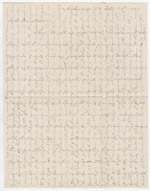 | Letter from James Southgate to Delia Haywood Southgate, Annie Moore Southgate, Mattie Logan Southgate, James Haywood Southgate, Celestia Muse Southgate, and Sarah Anne Wynne Raboteau, September 23, 1883 James Southgate writes his wife, children and sister, about the inclement weather in Richmond and the medical treatment he receives there. He remarks about his weight loss and relates the different theories that his physicians, his sister Sarah Raboteau and his cousin Augusta Christian have about treating "feeble digestion" or "Dyspepsia." He shares details of his medical regimen and the effects of the medications on his mouth. While watching church goers in the rainy streets of Richmond, James ruminates on the weather's effect on religious practice. James expresses his wish to visit his relations in eastern Virginia with his physician's approval. He responds to news from his family about Grandma Zack and Ed Sym and notes that he dined on oysters. | |
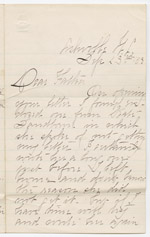 | Letter from Mattie Logan Southgate to James Southgate, September 23, 1883 Mattie Logan Southgate sends news concerning Minnie Moore's death to her father, James Southgate, who has traveled to Richmond, Virginia. She further describes the ill health that afflicts little Mary Blackwell and Mrs. Lockhart. Mattie refers to the letter Kate Sanborn sent to her father. She describes her visits with different Asheville friends and relatives and the poor quality of vocal and instrumental music that she heard there. | |
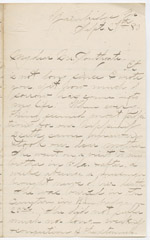 | Letter from Kate Christine Sanborn to James Southgate, September 27, 1883 Kate Christine Sanborn expresses her grief to James Southgate about the recent loss of her mother, Susan Sanborn. Kate notes that her father and seven of her siblings have already died. | |
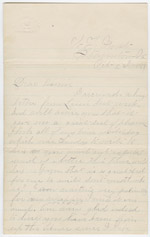 | Letter from Mattie Logan Southgate to Annie Moore Southgate, November 24, 1881 Mattie Logan Southgate tells her sister Annie Southgate about her Wesleyan Female Institute roommates, Leland Sneed, Mettie Ricketts, and Mollie Page. Mattie refers to Minnie Moore, another school friend from Durham. She mentions the Methodist Episcopal Church, South Annual Conference, which was held in Durham, North Carolina in November 1881, and asks that her family send her a care package for Christmas. | |
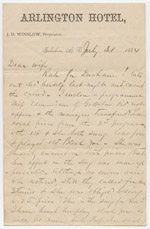 | Letter from James Southgate to Delia H. Southgate, July 31, 1884 James Southgate writes his wife, Delia Southgate with news of their daughter Lessie's performance in Goldsboro: "Rah for Durham! Cats out did herself last night and carried the crowd." James reports on their train travel through Raleigh to Goldsboro. | |
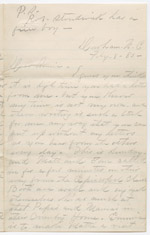 | Letter from Celestia Muse Southgate to Annie Moore Southgate, February 08, 1885 In this letter, from Lessie Southgate to, her sister, Annie Moore Southgate, Lessie (Celestia Muse) Southgate describes events occurring in Durham: a sermon, "musicale," and an upcoming Valentine's Day party. Lessie shares news about the Duke family, Lipscomb family, Blackwell family, Carr family, and Lockhart family. Lessie depicts a horseback outing with Emma Lockhart, Julian S. Carr, and others. While riding through Hayti, she stopped to to see Adaline, one of the family's domestic servants, who is ill. Lessie mentions the arrival of the "Wizzard Oil Band of Singers," a group that performs open air concerts. She concludes her note with humorous news of Annie's dog, Zoe. | |
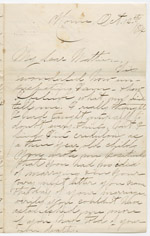 | Letter from Kate Sanborn to Mattie Logan Southgate, October 12, 1884 In this letter, from Kate Sanborn to Mattie Southgate, Kate reacts with surprise to Mattie Southgate's announcement of her upcoming wedding. She berates Mattie for setting a date for the wedding while neglecting to inform her of the groom's name. Kate wonders whether the groom is Capt. Wahab or Mr. Duke. | |
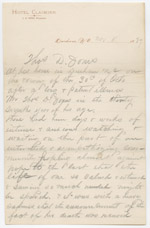 | Obituary by A. S. DeVlarming for Thomas Decatur Jones, November 08, 1889 A. S. DeVlarming writes an obituary for his employer Thomas Decatur Jones (1852-1889) on Hotel Claiborn stationery. The Claiborn hotel was located in Durham, North Carolina during the 1880s. | |
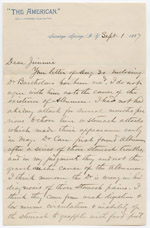 | Letter from James Southgate to James Haywood Southgate, September 01, 1887 In this letter to his son James H. Southgate, James Southgate discusses his medical condition diagnosed by Dr. A.G. Carr, Dr. Bartholow, and Dr. Frank D. Cunningham. James Southgate worries about Eugene Morehead's health and the future of the Durham bank should Morehead die. Southgate describes his diet at his hotel in Saratoga Springs and gives a report on a prayer meeting held by Reverend Dr. Simpson of t he New York Tabernacle. He anticipates his journey home and wonders if he will, upon his return, feel like Rip Van Winkle. | |
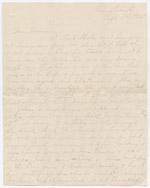 | Letter from Bettie Ann Cunningham to Thomas Decatur Jones , September 08, 1885 Writing from Greensboro, North Carolina, Bettie Ann Cunningham asks her brother Thomas Decatur Jones about his expectant wife Mattie Logan. "I hope she is not uneasy and bears her trouble bravely. I believe all the ladies this year have gone a month over their time and all of them have had girls so be prepared for such a calamity as you men regard it." She also describes her brother John K. Jones' accident and how poor communication between his siblings and their mother Nancy Harriet Keen Jones delayed his medical care. In closing, Bettie advises Thomas to attend Mrs. Chapin's temperance speech when the lecturer travels to Durham. | |
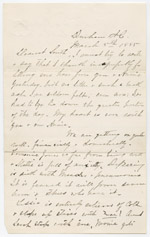 | Letter from Delia Haywood Southgate to James Southgate, March 05, 1885 Delia Southgate writes her husband, James Southgate, that their son-in-law Thomas Decatur Jones is unwell and their daughter Mattie Logan Southgate Jones is full of anxiety. In addition, she notes that Jones's book keeper A.S. DeVlarming suffers from measles and pneumonia. Delia gives news about the health of every one at home: Lessie has recovered from a cold and sleeps with the dog, Zoe. Aunt Sarah Raboteau sleeps with Delia. She mentions Aunt Sarah's squabbles with the cook Neomie. Delia closes with a request that her husband purchase some artwork. | |
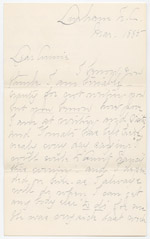 | Letter from Mattie Logan Southgate Jones to Annie Southgate, March 1885 Mattie Southgate Jones writes, her sister, Annie Southgate with news of illnesses and happenings in the Durham community. "Tomato" (a pet name that she uses for her husband, Thomas Decatur Jones) and A.S. DeVlarming, her husband's book-keeper have battled fever and measles, respectively. Mrs. Bob Jones experienced a miscarriage, Kate Conrad battles pneumonia and DeVlarming copes with measles. She reports that her sister Lessie will work together with Mrs. George Watts, Dora Fanning, Minnie Carter, and, Marion Fuller to organize a concert. Mattie shares news of her visitors. She mentions her garden, quilt making, and embroidery. | |
 | Letter from Delia H. Southgate to Annie Moore Southgate, February 09, 1885 Delia Southgate writes her daughter, Annie Moore Southgate, who has traveled to Richmond for medical care at Dr. Frank D. Cunningham's Retreat of the Sick. | |
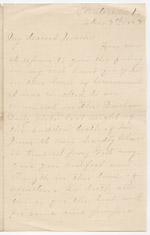 | Letter from Mollie Page to Mattie Logan Southgate Jones, November 08, 1889 Upon reading a death notice for Thomas Decatur Jones (1852-1889) in the Durham Daily Globe, Mollie Page writes her friend Mattie Logan Southgate Jones to express her condolences. Mollie Page and Mattie Southgate Jones roomed together at the Wesleyan Female Institute in Staunton, Virginia. | |
 | Letter from Mettie Ricketts to Mattie Logan Southgate Jones, November 11, 1889 Mettie Ricketts sends her friend, Mattie Southgate Jones a letter of sympathy on the death of her husband Thomas Decatur Jones (1852-1889). Mettie Ricketts and Mattie Southgate attended the Wesleyan Female Institute in Staunton, Virginia during the early 1880s. | |
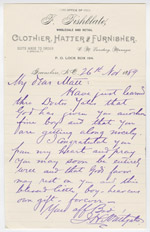 | Letter from James Haywood Southgate to Mattie Logan Southgate Jones, November 26, 1889 In this letter, from James Haywood Southgate to, his sister, Mattie Logan Southgate Jones, James congratulates Mattie Southgate Jones on the birth of her son, Thomas Decatur Jones. Her brother prays to God for her speedy recovery from the pains of childbirth. He writes the letter on F. Fishbate Wholesale and Retail: Clothier, Hatter, and Furnisher's stationary, which was located in Greensboro, North Carolina. | |
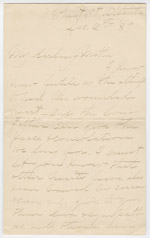 | Letter from Kate Christine Sanborn to Mattie Logan Southgate Jones, December 06, 1889 Kate Christine Sanborn expresses her sympathy to her friend Mattie Logan Southgate Jones on the death of Thomas Decatur Jones (1852-1889). | |
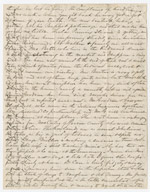 | Letter from James Southgate to Mattie Logan Southgate Jones, circa 1885 In this fragment of a letter, James Southgate takes his daughter on an imaginary walking tour of Durham where he visits with her friends, neighbors and town luminaries. Southgate reports on the news and gossip of the day: Durham's tobacco entrepreneurs, Blackwell & Goodson dissolved their partnership, Dr. A.G. Carr sold his stock of medicines to the druggists Vaughan & Tenny, Mrs. Battle struggles while her husband Dr. Lee W. Battle seeks treatment for his opium habit at the Asylum, and the Lehman family purchases a new piano. Additionally, Southgate supplies his daughter with tidbits of news concerning the Halliburton, Lyon, Smith, Perry, Phillips, Lockhart, Watts, Howerton, Farthing, Angier, McCabe, Thomas, Walker, Betts, Burton, Cooper, Rowland, Miller, Fuller, Gammon, Hopkins, Day, Mohsberg, Levy, Fawcett, Wilkerson, and Dalby families. | |
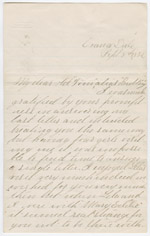 | Letter from unknown author to Mattie Logan Southgate, September 08, 1882 Mattie Logan Southgate ("Tom) received this letter from a schoolmate writing under the alias of "bed bug.". The author mentions hosting Mollie Page and Leland Sneed, two Wesleyan Female Institute friends who reside in Virginia. There is a strong likelihood that Mettie Ricketts, Mattie's friend from W.F.I. authored this letter. The author tells Mattie of a horseback ride with Jim White and the young man's expression of "undying love" for her. She describes her travels with Mollie Page and Leland Sneed to Red Hill and the picnic and dances they attended. She closes with her plans to commence teaching and asks Mattie if she intends to continue her studies at the Wesleyan Female Institute. | |
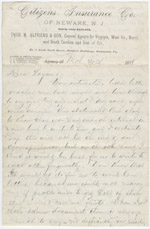 | Letter from James Haywood Southgate to Mattie Logan Southgate, March 20, 1878 James Haywood Southgate compliments his sister, Mattie Southgate, on her improvement in penmanship. He tells her of his visit with Dr. Le Doux and his wife and remarks that he feels "like getting a wife myself." James confides that he will not marry until he has $10,000 in the bank. This letter is written on stationery from the Citizen's Insurance Company of Newark, New Jersey. | |
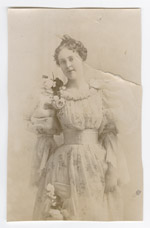 | Photograph of Lillie Parrish Portrait of Lillie Parrish, daughter of Edward James Parrish and Rosa Parrish. | |
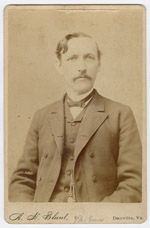 | Photograph of Thomas Decatur Jones (1852-1889) Portrait of Durham tobacco dealer Thomas Decatur Jones (1852-1889). Image made at the A. H. Blunt photographic studio, Danville, Virginia. | |
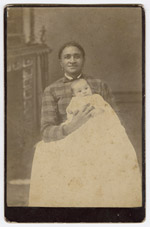 | Photograph of Thomas Decatur Jones (1887-1893) Photograph of an unidentified black servant holding Thomas Decatur Jones (1887-1893), son of Mattie Logan Southgate Jones and Thomas Decatur Jones (1852-1889). | |
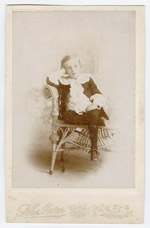 | Photograph of Albert Lyell Jones Portrait of Albert Lyell Jones (1889-1913), youngest son of Mattie Logan Southgate Jones and Thomas Decatur Jones (1852-1889). Image made at the W. Shelburn photographic studio, Durham, North Carolina. | |
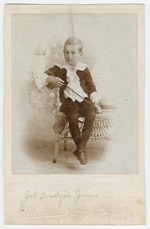 | Photograph of James Southgate Jones Portrait of James Southgate Jones (1888-1949), son of Mattie Logan Southgate Jones and Thomas Decatur Jones (1852-1889). Image made at the W. Shelburn photographic studio, Durham, North Carolina. | |
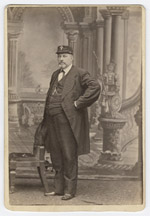 | Photograph of James Southgate (1832-1914) Portrait of James Southgate (1832-1914) taken at the Helser & Peabody studio, Chicago, Illinois. | |
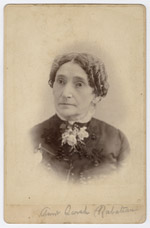 | Photograph of Sarah Ann Wynne Raboteau Portrait of Sarah Ann Wynne Raboteau (1816-1895), widowed sister of Delia Haywood Wynne Southgate. Image made by W. Shelburn photographic studio, Durham, North Carolina. | |
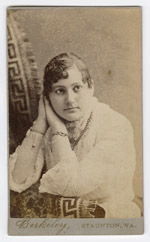 | Photograph of Mattie Logan Southgate Portrait of Mattie Southgate, student at the Wesleyan Female Institute. Image made by Edmund Berkeley's studio in Staunton, Virginia. | |
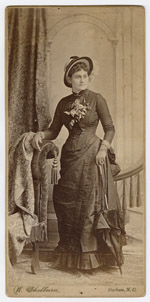 | Photograph of Annie Moore Southgate Portrait of Annie Moore Southgate (1861-1886), daughter of James Southgate and Delia Haywood Wynne Southgate. Image made by the W. Shelburn photographic studio, Durham, North Carolina. | |
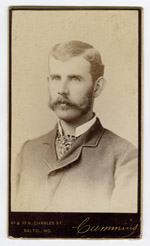 | Photograph of Tommie Wilkinson Portrait of Tommie Wilkinson. | |
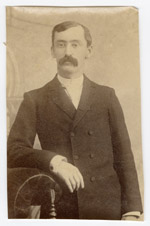 | Photograph of Edwin W. Kennedy Portrait of Professor Edwin W. Kennedy, Superintendent of Durham City Schools from 1882 to 1894. | |
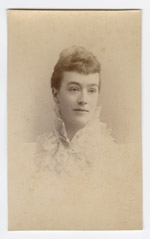 | Photograph of Marion Kennedy Portrait of Marion Kennedy, wife of Edwin W. Kennedy. | |
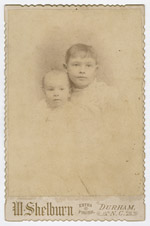 | Photograph of Thomas Fuller Southgate and Mena H. Southgate Portrait of Thomas Fuller Southgate (1890-1954) and his sister Mena Southgate (1888-1898), children of James H. Southgate and Kate Shepherd Fuller Southgate. Image made by W. Shelburn photographic studio, Durham, North Carolina. | |
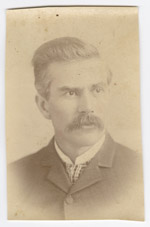 | Photograph of Albert H. Stokes Portrait of Albert H. Stokes (1844-1899). | |
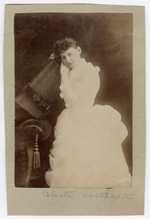 | Photograph of Lessie Southgate Portrait of Celestia Muse "Lessie" Southgate (1863-1914) holding an autoharp. | |
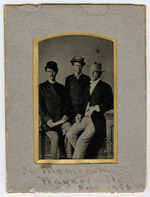 | Photograph of Thomas Decatur Jones (1852-1889) with his friends S.H. Hardwick of Montgomery, Alabama and R. W. Baird of Johnsville, Virginia. The image commemorates an excursion to Waynesville, N.C. "on or about the 6th of September 1880." Portrait of the Waynesville Trio, including Thomas Decatur Jones (1852-1889) on the left | |
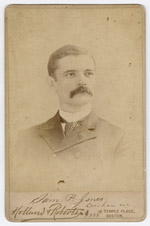 | Photograph of Sam P. Jones Portrait of Sam P. Jones, noted evangelist who held a revival in Durham, North Carolina in October 1889. | |
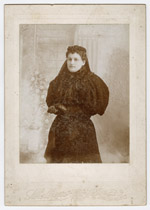 | Photograph of Mattie Logan Southgate Jones Portrait of Mattie Logan Southgate Jones (Mrs. Thomas Decatur Jones), dressed in black. The photograph was taken at the W. Shelburn photographic studio, Durham, North Carolina. | |
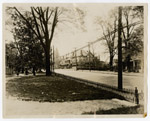 | Photograph of Chapel Hill Street looking west toward Duke Memorial Church Photograph taken from the front yard of the Thomas Decatur Jones and Mattie Southgate Jones residence at 307 W. Chapel Hill Street in Durham, North Carolina. Duke Memorial United Methodist Church stands on the north side of W. Chapel Hill Street. | |
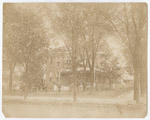 | Photograph of the Thomas Decatur Jones and Mattie Southgate Jones residence Photograph taken from the front yard of the Thomas Decatur Jones and Mattie Southgate Jones residence at 307 W. Chapel Hill Street, in Durham. | |
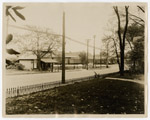 | Photograph of Chapel Hill Street from the front yard of the Thomas Decatur Jones and Mattie Southgate Jones residence Photograph taken from the front yard of the Thomas Decatur Jones and Mattie Southgate Jones residence at 307 W. Chapel Hill Street, in Durham, looking north towards the railroads tracks and the Walker Warehouse built by the American Tobacco Company in 1897. | |
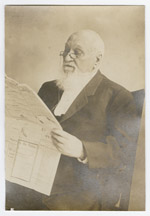 | Photograph of James Southgate Portrait of James Southgate (1832-1914) reading the newspaper. Image taken at Miss Katie Johnson's studio, Durham, North Carolina. | |
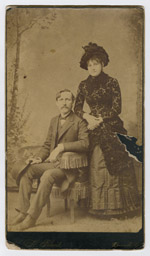 | Photograph of Thomas Decatur Jones and Mattie Logan Southgate Jones Portrait of Thomas Decatur Jones (1852-1889) and his wife, Mattie Logan Southgate Jones. Image taken at the A. H. Blunt studio in Danville, Virginia. | |
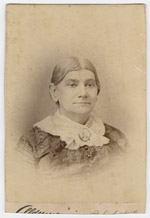 | Photograph of Delia Haywood Wynne Southgate Portrait of Delia Haywood Wynne Southgate (1826-1888), mother of Mattie Logan Southgate Jones. | |
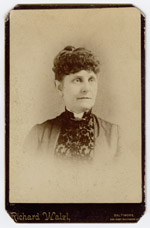 | Photograph of Cordelia Hunter Southgate Portrait of Cordelia Hunter Southgate (1840-1894), sister of James Southgate. Image taken at the Richard Walzl studio, Baltimore, Maryland. | |
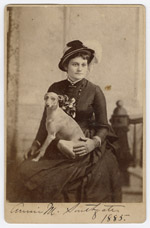 | Photograph of Annie Moore Southgate with her Italian Greyhound, Zoe Portrait of Annie Southgate with Zoe, her Italian Greyhound.. Portrait was taken at the Shelburn Studios in Durham. | |
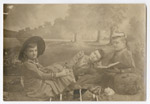 | Photograph of Mattie Faucette, Lillie Parrish, Lalla Ruth Carr Portrait of three girls: Mattie Faucette, Lily Parrish, Lalla Ruth Carr, pupils at Lessie Southgate's School of Music. | |
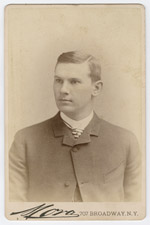 | Photograph of James Haywood Southgate Portrait of James Haywood Southgate as a young man. | |
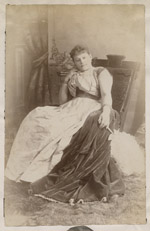 | Photograph of Lessie Southgate Portrait of Lessie Southgate reclining in chair with feather. | |
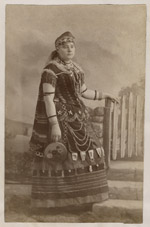 | Photograph of Lessie Southgate Picture of Lessie in exotic costume. | |
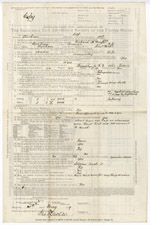 | Life insurance policy for Richard Harvey Wright, 1877 Copy of life insurance policy application submitted by Richard H. Wright to James Southgate in 1877. The form provides information about the health of Richard, his siblings and his parents. | |
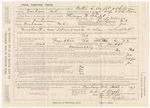 | Life insurance policy for Thomas D. Wright, 1887 Copy of life insurance policy application submitted by Thomas D. Wright to James Southgate in 1887. The form provides information about the health of Thomas and his siblings and his parents. | |
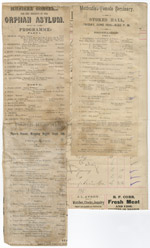 | Lessie Southgate's Scrapbook (Excerpts) A page of concert programs from Lessie Southgate's scrapbook. These items document concerts given by Lessie Southgate, her School of Music students, and friends in Durham, North Carolina around 1885. | |
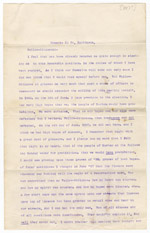 | James Southgate prohibition speech Speech of James Southgate in support of prohibition work. | |
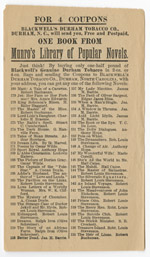 | Blackwell's Durham Telegraph: dime novel promotion In the late 1890s, Blackwell's Durham Telegraph offered consumers of Genuine Bull Durham Smoking Tobacco free popular literature from Munro's Library of Popular Novels in exchange for coupons from their tobacco products. This catalogue describes the promotion and lists the titles available. | |
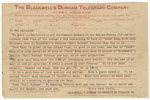 | Blackwell's Durham Telegraph : cork soap promotion Promotional material published by Blackwell's Durham Telegraph, the advertising division of Blackwell's Durham Co-operative Tobacco Company, offering free soap to those businesses which purchased 25-pound cases of Blackwell's Genuine Bull Durham Tobacco. | |
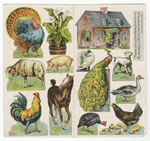 | Blackwell's Durham Telegraph: farm yard paper dolls Blackwell's Durham Telegraph published this sheet of paper dolls depicting farm-yard animals as a promotion for their tobacco products. | |
 | Panoramic photograph, American Tobacco factory in Durham looking to the East This panoramic view of Durham, North Carolina shows the factory of the American Tobacco Company, the original home of the W. T. Blackwell & Company enterprise, producer of Bull Durham Smoking Tobacco. This view was shot from the western edge of the factory complex looking eastward over the Washington Building. The image appeared in Durham, North Carolina: A Center of Industry and Education, a publication issued by the Durham Chamber of Commerce in 1926. | |
 | Panoramic photograph of Parrish Street in Durham This panoramic view of Parrish Street (circa 1926) features the six-story headquarters of the North Carolina Mutual Life Insurance Company, a company established by black entrepreneurs, John Merrick, Dr. Aaron M. Moore, and Charles Clinton Spaulding. The firm's headquarters (as depicted in this image) was designed by Durham architects Rose and Rose and erected in 1921. Five years later, the building, located at 114-116 Parrish Street, housed the Mechanics and Farmers Bank, North Carolina Mutual Life Insurance Company, Mutual Building & Loan Association, and the Merrick-McDougald-Wilson Company. After North Carolina Mutual Life Insurance Company moved to its new headquarters on Chapel Hill Street in 1965, the old headquarters on Parrish Street was renamed the Mechanics & Farmers Bank building. The right panel of this photograph features the Durham County Courthouse (erected in 1916) and the Union Depot, both designed by Milburn and Heister Company, architects. | |
 | Panoramic photograph of the American Tobacco Company and downtown Durham The left panel of the panoramic image features the historic W.T. Blackwell and Company Factory built in 1874, and an extensive manufacturing plant owned by the American Tobacco Company. At the horizon in the center panel are the twin steeples of Duke Memorial Church and the Liggett & Myers plant; railyards and commercial buildings sit in the foreground. The right panel features buildings near the intersection of Main and Corcoran streets including the Durham Loan & Trust Building, the Washington Duke Hotel, the United States post office (built in 1904), Wright Corner, and the Geer Building. Holladay Studio shot the image for the 1926 Durham Chamber of Commerce publication, Durham, North Carolina: A Center of Industry and Education. | |
 | Panoramic photograph of downtown Durham looking west This panoramic view, taken from the Washington Duke Hotel, captures several landmarks. On the left, at the corner of Blackwell and Pettigrew streets, sits the historic W. T. Blackwell & Company Tobacco Factory, purveyor of Bull Durham tobacco, and part of the American Tobacco Company. The Liggett & Myers plant sits in the center panel near the horizon. The Imperial Tobacco Company and the Durham High School appear in the distance of the right panel. In the foreground on the right, sits the Durham Auditorium (now the Carolina Theatre). Holladay Studios shot the image which appears on p. 10 of the 1926 Durham Chamber of Commerce publication, Durham, North Carolina: A Center of Industry and Education. | |
 | Panoramic photograph, view of Erwin Cotton Mills This photograph shows a panoramic view of the Erwin Cotton Mills, originally established in 1892 by Benjamin N. Duke and his partners. The mill complex contained manufacturing and storage facilities as well as a company town with millworker housing and a general store. Remaining structures from the Erwin Cotton Mill, are located near Main and Ninth Streets in Durham. This image appears in the 1926 Durham Chamber of Commerce publication entitled, Durham, North Carolina: A Center of Industry and Education. | |
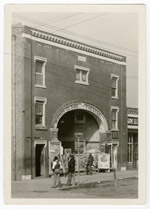 | Photograph of Wonderland Theater in Durham Photograph of the Wonderland Theater, located on the corner of Pettigrew and Ramsey streets. This theater, owned by "movie king" Frederick K. Watkins offered entertainment for Durham's black residents. A poster advertises The Barrier, starring Lionel Barrymore. | |
 | Photograph of Golden Belt Manufacturing building Photograph of the Golden Belt Manufacturing building with people standing outside. The Durham Chamber of Commerce published this image in their 1926 brochure entitled Durham, North Carolina: A Center of Industry and Education. | |
 | Panoramic photograph, view of Union Station looking East This Holladay Studio image presents a panoramic view of Durham from the Durham County Courthouse on Main Street to St. Joseph's AME Church on Fayetteville Street. The view depicts (from left to right) Durham County Courthouse, Hotel Lochmoor, E.H. & M.V. Lawrence, wholesale millers, Union Station, and St. Joseph's AME Church. | |
 | Panoramic photograph of Erwin Cotton Mills with mill housing Holladay Studio photographed Erwin Cotton Mills and the company's housing for its employees, which is located nearby the mill. | |
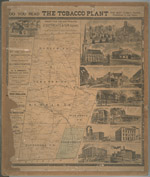 | Map of Durham County, N.C. This 1887 map indicates the location of landowners, churches, quarries, saw mills, creeks, railroads and a coal mine. Includes advertisements for local businesses including the newspaper Tobacco Plant, Seeman Printery, Vaughn & Tenny, druggists and fourteen illustrations of: Morris & Son factory, J.S. Carr’s residence, E.J. Parrish’s residence, Trinity Church, Banner Ware-house, View of Main Street, View of Mangum Street, Durham Hotel (Claiborn), E. Morehead & Co. bankers, Globe warehouse, Durham Cotton mills, Z.I. Lyon & Co.’s tobacco factory, Blackwell’s Co-operative tobacco factory, and W. Duke Sons & Co.’s factory. The map provides the names and boundaries of six Durham County townships including Mangum, Lebanon, Durham, Patterson, Oak Grove, and Cedar Fork. Scale [ca. 1:63,360]. | |
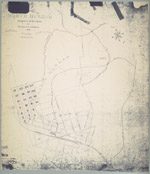 | Map of the town of North Durham: property of B. L. Duke and its relative position to Durham, North Carolina An 1890 map showing the property owned by Brodie Leonidas Duke in Durham, North Carolina, just east of Trinity College, in an area now identified as Trinity Park. The map also provides names of downtown streets, shows the location of Bobbin & Shuttle Mills, fertilizer factory, cotton factory and railroad lines. Scale 400 feet to 1 inch or [ca.1:4800]. | |
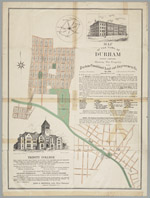 | Map of the town of Durham, North Carolina:showing the property of the Durham Consolidated Land and Improvement Company This 1890 map published by the Durham Consolidated Land & Improvement Company indicates its property holdings north and west of Trinity College, Durham, North Carolina, in areas now known as Trinity Heights, Walltown, and Old West Durham. Contains an advertisement with illustration promoting Trinity College as well as a letter by Richard H. Wright, secretary of the Company, extolling the virtues of Durham's business climate. In 1890, the Durham Consolidated Land & Improvement Company published this map to indicate its property holdings north and west of Trinity College in an area now known as Trinity Heights, Walltown, and Old West Durham. The map also provides some information about streets near the Blackwell Tobacco Factory, now Downtown Durham. It also features an advertisement promoting Trinity College as well as the virtues of Durham's business climate. | |
 | Bird's-Eye View of the City of Durham, North Carolina, 1891 This 1891 map shows an aerial view of Durham and provides an extensive index to the location of tobacco warehouses, factories, restaurants, groceries, dry goods dealers, churches, and residences located in Durham. Business owners include: Robert I. Rogers, Richard B. Fitzgerald, W. Shelburn, photographer, Q. E. Rawls, dry goods and many others. Also mentioned are the editors of the local newspapers E.C. Hackney of the Durham Recorder, Al Fairweather of the Durham Daily Globe, and J.A. Robinson of the Durham Daily Sun. | |
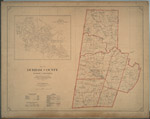 | Map of Durham County, North Carolina prepared by the direction of the County Commissioners from actual surveys This 1920 map provides two views of Durham County. One view delineates the school districts in Durham County and indicates which schools served white or black pupils. It also identifies Mangum, Lebanon, Durham, Oak Grove, Carr, Patterson, and Cedar Fork townships and provides locations for cemeteries and roads. Another view labelled Cities of East and West Durham identifies street names for areas that are now customarily referred to as Old West Durham, including the Ninth Street business district, Trinity Park, Trinity Heights, Walltown (portion), Duke University (East Campus), Old North Durham, Downtown Durham and Fayetteville Street (Hayti), West End, Morehead Hill (portion), Edgemont and Morning Glory, Cleveland-Holloway Street, East End, East Durham (portion). | |
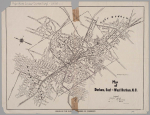 | Map of Durham, East and West Durham, N.C. A 1924 Durham Chamber of Commerce map depicting schools, mills, factories, and cemeteries in Durham. This map contains information pertaining to neighborhoods now commonly referred to as: West End, Lyon Park, West Durham (area surrounding Erwin Mills), Pearl Cotton Mills Village, Duke University (East Campus), Trinity Heights, Walltown, Trinity Park, Old North Durham, Morehead Hill, Duke Park, Downtown Durham (Central Business District), Cleveland-Holloway Street, East End, East Durham (portion), Edgemont and Morning Glory near the Golden Belt Manufacturing Company, Hayti. The map identifies street names and the location of hydrants, fire alarm boxes and fire stations. | |
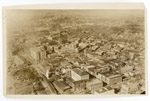 | Aerial photograph of Durham looking toward the Northwest This aerial view of downtown Durham was taken prior to the completion of the Washington Duke Hotel (ciirca 1925). In the foreground on Main Street are the First Presbyterian Church and Durham County Courthouse. The view also shows Union Station, Liggett & Myers and Imperial Tobacco. Durham High School and the Pearl Mill Village are visible in the background. | |
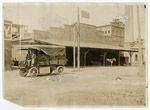 | Photograph of Electric, Ice Plant, Durham Traction Company A 1914 photograph of the Durham Traction Company Light and Power building, in front of which sits a motorized "Electric Truck No. 1," as well as horse-drawn wagons. Richard Harvey Wright was the first president of the company; Julian Shakespeare Carr served as Vice President. | |
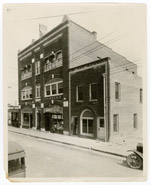 | Photograph of Pender's Grocery Store, 709 Fayetteville Street, Durham, North Carolina This photograph depicts Pender's Stores Co., grocers, and the Hunter Masonic Temple located at 709 Fayetteville Street in the Hayti neighborhood of Durham, North Carolina. Signs in the grocery store window advertise beans, peas, lye and sugar. A gentleman stands in the doorway of the building adjacent to Pender's where the glass windows advertise the offices of Dr. Cordice, physician and surgeon. | |
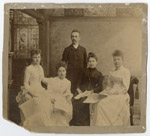 | Photograph of Gilmore Ward Bryant with pupils from Southern Conservatory of Music Portrait of Gilmore Ward Bryant and his students from the Southern Conservatory of Music, Durham, North Carolina. | |
 | Blackwell's Durham Telegraph dime novel promotion : envelope Blackwell's Durham Telegraph Promotional material sent by Blackwell's Durham Telegraph, the advertising arm of Blackwell's Genuine Bull Durham Smoking Tobacco, to a customer in Salt Lake City. The envelope is addressed to a customer in Salt Lake City, Utah. The envelope contained a coupon for promotional gifts to customers who bought tobacco from William Blackwell's Genuine Tobacco Bull Durham Smoking Tobacco. | |
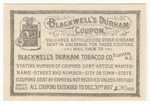 | Blackwell's Durham Telegraph dime novel promotion : coupon from Blackwell's Durham Tobacco Co., Blackwell's Durham Telegraph, the advertising arm of Blackwell's Genuine Bull Durham Smoking Tobacco, sent promotional coupons with illustrations of : paper dolls, silver scarf pins, silver-plated tableware, razors, scissors, or pocketwatches. The items are sent from Durham, North Carolina to customers via mail by Blackwell's Durham Telegraph. Blackwell's Durham Telegraph sent coupons to customers who bought cigarettes around the world. Customers who regularly bought Blackwell's cigarette accumulated coupons for redemption. | |
 | Blackwell's Durham Telegraph dime novel promotion : valuable; the coupon inside this envelope is the regular coupon Blackwell's Durham Telegraph, the advertising arm of Blackwell's Genuine Bull Durham Smoking Tobacco, sent an envelope to promote Blackwells' Genuine Durham Smoking Tobacco. | |
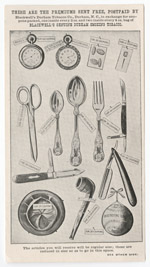 | Blackwell's Durham Telegraph dime novel promotion : coupon from envelope entitled, valuable Promotional material sent by Blackwell's Durham Telegraph, the advertising arm of Blackwell's Genuine Bull Durham Smoking Tobacco. Blackwell's Durham Telegraph sent coupons to consumer's who purchased tobacco products. Customers exchanged these coupons for promotional merchandise. | |
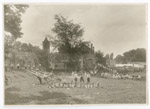 | Photograph of children in playground with ball Durham Chamber of Commerce photograph of children playing on a playground with a ball, on a see-saw, and with other toys. In the background is an advertisement for BC Headache products. | |
 | Durham, the queen of the golden belt An pamphlet created by Durham Consolidated Land and Improvement Company to promote investment in businesses and real estate in Durham, North Carolina. Includes three lithographs of buildings in Durham: Main Building at Trinity College; West End Cotton Factory; and Wescarr Knitting Mill. Durham is described as a sophisticated town with well-developed industrial, commercial, and residential districts for: plants, mills, factories, railroad stations and tracks, banking facilities, schools, churches, and colleges. | |
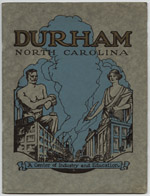 | Durham, North Carolina, a center of education and industry A Durham Chamber of Commerce booklet published in 1926, Durham, North Carolina, a Center of Education and Industry presents the "story of Durham's rise to a self-conscious power in the progress of the New South." Descriptions highlight Durham's crops, manufacturing, churches, businesses, housing and recreational facilities. Includes more than 35 pages of photographs with captions and an architectural rendering of a planned suburb in the Hope Valley area of Durham. | |
 | Plans and Details of Works of The Durham Water Co. Durham N.C. 1887 This large map contains a series of smaller maps and illustrations which show the means by which Durham residents received water from the Eno River. Included are: "Plans of Storage Reservoir Dam," "Plan of Distributing Reservoir," "Plan of Power and Storage Reservoirs," and the "Pipe Distribution System." This latter map provides details of street names within the Town of Durham and the diameter of water pipes as well as the location of hydrants and gates in 1887. | |
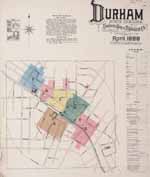 | Sanborn Fire Insurance Map, Durham, North Carolina, 1888 This fire insurance map by the Sanborn Map & Publishing Company provides a detailed look at the commercial buildings that stood within the town limits of Durham, North Carolina in 1888. The map contains an index page to city streets and the location of the county courthouse, jail, churches, manufacturers, tobacco warehouses and prizing establishments, mills, stables, and other enterprises. The map's legend provides details about the construction of the buildings (whether they have been built from stone, brick or wood) as well as details about the number of stories and windows. The map also lists the type of commercial enterprises housed in various structures. For larger businesses, the cartographer details the number of workers employed and describes the establishments’ fire-fighting capabilities. Scale ca. 1" = 50 feet. A georeferenced version of this map is also available on the Digital Durham website. | |
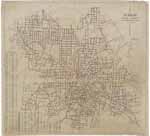 | Durham, North Carolina / Department of Public Works/ 1930 This map of the city of Durham, North Carolina provides information about street names as well as the diameter and location of sewer lines in 1930. | |
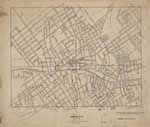 | Map of Durham, N.C. showing sewer system T.N. Thaxton penned this map of the city of Durham, North Carolina sometime in the 1920s. It provides information about street names as well as the diameter and location of sewer lines in the early 1920s. Also includes names and locations of churches and schools, railroad lines, hospitals, and cemeteries. Scale: 1” = 400 feet or [1:4,800]. | |
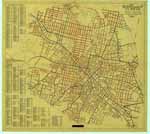 | Durham, North Carolina / Department of Public Works/ 1951 This map of Durham, North Carolina, created by the Department of Public Works, appears to have been modified between its initial publication in 1948 and 1951. The legend indicates that color annotations were introduced in 1951 which help the user distinguish between “highway system streets” (marked in black) and “streets conforming to the requirements of chapter 260 of the 1951 Session Laws (marked in red). There are three dates on this map: May 1948 which is crossed out, November 10, 1950, and July 1951. The map provides street names as well as an index to streets within the city of Durham, North Carolina a list of schools with identifying markers and other sites including parks, hotels, fire houses, government buildings and libraries. | |
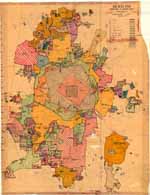 | Durham, North Carolina: Annexation Map The base of this annotated street map was first produced by the Department of Transportation and Utilities, Durham, N.C. in 1979. From the 1980s to 2001, two employees of Durham's Department of Public Works developed this annexation map to illustrate the City of Durham's growth from 1890 to 2001. Pen and ink notations demarcate where the city limits stood in 1890, 1901, 1925, 1957, 1960, and 1966. A color legend indicates when the city added parcels of land between 1970 and 2000. The map provides information the size of parcels, name of developer or development and date of annexation. The map was developed by Lee Ribet and later updated by Tina Raneri, both employees of the Department of Transportation and Utilities, later known as the Department of Public Works. Scale 1 inch = 1600 feet or [ca. 1:19,200]. | |
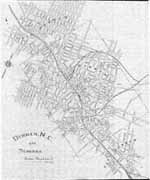 | Durham, N.C. and Suburbs This 1914 map of Durham, North Carolina provides details on the town of Durham and the suburban regions of West Durham and East Durham. The map delineates the town's corporate limits, identifies the name and location of schools, some manufacturers, and railroad lines. The map also provides street names for areas that are now customarily referred to as Old West Durham, including the Ninth Street business district, Trinity Park (portion), Trinity Heights, Walltown (portion), Duke University (East Campus), Old North Durham, Downtown Durham and Fayetteville Street (Hayti), West End, Morehead Hill (portion), Edgemont and Morning Glory, Cleveland-Holloway Street, East End, East Durham (portion). Scale: 800 feet per inch. | |
 | Map of Forest Hills/ Durham, N.C. Owned by New Hope Realty Co. This map drawn by E.H. Copley in 1927 provides a detailed rendering of individual lots owned by the New Hope Realty Company in Forest Hills, Durham, N.C. and their measurements as they were recorded in plot book 6 at the Registrar of Deeds office. The map also provides names of streets. Scale 1" = 100 feet. | |
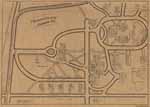 | Trinity College/Durham, N.C. W.P. Budd's map of the Trinity College, Durham, North Carolina identifies key structures and indicates where they stood on campus in 1902. The map includes the location of the chapel, library, dormitories, recreational areas, and stables as well as the homes of professors John Spender Bassett, William I. Cranford, Edwin Mims, William H. Pegram, A. H. Merritt, M. J. Edwards, Robert L. Flowers, and President John C. Kilgo. Additionally, the map shows the location of Watts Hospital and Trinity Park School as well as railroad and streetcar lines. Some of the homes illustrated on this map were later moved to the eastern side of Buchanan Avenue, in the Trinity Park neighborhood. | |
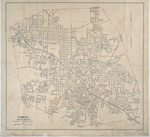 | Durham, North Carolina This 1925 Durham, North Carolina map produced by the Department of Public Works provides information on streets and the layout of railroad lines in the city of Durham. The map contains annotations in red pencil. Scale [ca. 1:9,500]. | |
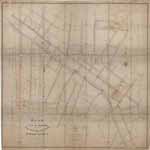 | Plan of the Town of Durham Showing Pipe Distribution of the Durham Water Company This map provides details of street names within the town of Durham and indicates the diameter of water pipes and location of hydrants as of 1887. Scale: 200 feet per inch or [1:2,400]. | |
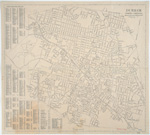 | Durham, North Carolina This 1945 map produced by the Department of Public Works (dated July 1, 1945) contains a listing of streets and an index to city resources such as the post office, court house, parks, hospitals, libraries, U.S.O. buildings, and schools. Scale [ca. 1:10,000]. | |
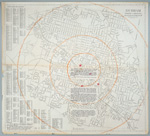 | Durham, North Carolina This street map of Durham, North Carolina was published in 1948. Two years later, an unknown annotator used the map to illustrate the effect an atomic bomb blast would have on the city of Durham. The map contains several typewritten notes which predict the potential damage to buildings and the populations. | |
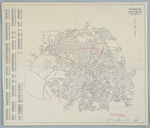 | Durham, North Carolina The Department of Public Works produced this map of Durham, North Carolina in 1957. It contains an index to streets and a listing of places of "public interest" including the post office, court house, parks, hospitals, libraries, U.S.O. buildings, schools and colleges. The map bears red pencil marking by an unknown annotator. Scale 2000 feet per inch or [ca. 1:24,000]. | |
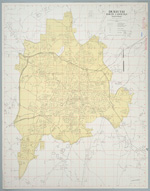 | Durham, North Carolina The Department of Public Works published this map of the City of Durham, North Carolina in 1967. It delineates the "city limit line" identifies railroad lines and distinguishes "highway system streets," "streets not opened to traffic," "Duke University streets," Interstate Highways, U.S. Highways and State Highways. The reverse side of the map provides an index to city streets. Scale 2000 feet per inch or [1:24,000]. | |
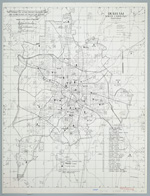 | Durham, North Carolina : map showing the voting precinct boundary lines and voting places of the city of Durham The Department of Public Works published this map of the City of Durham, North Carolina in 1970. It delineates the "city limit line" identifies railroad lines and distinguishes "highway system streets," "streets not opened to traffic," "Duke University streets," Interstate Highways, U.S. Highways and State Highways. The reverse side of the map provides an index to city streets. Additionally, the map provides a list of precincts and identifies the location of schools and fire stations within the city limits. Scale [ca. 1:28,000]. | |
 | Durham, North Carolina : map showing the voting precinct boundary lines and voting places of the city of Durham The Department of Public Works published this map of the City of Durham, North Carolina in 1970. It delineates the "city limit line" identifies railroad lines and distinguishes "highway system streets," "streets not opened to traffic," "Duke University streets," Interstate Highways, U.S. Highways and State Highways. The reverse side of the map provides an index to city streets. Additionally, the map provides a list of precincts and identifies the location of schools and fire stations within the city limits. Scale [ca. 1:28,000]. | |
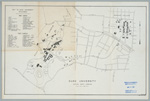 | Duke University This 1948 map of Duke University in Durham, North Carolina contains an index to buildings on both its West and East Campuses. Scale 1" = 800 feet or [ca. 1:9600]. | |
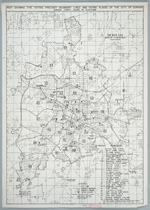 | Durham, North Carolina : map showing the voting precinct boundary lines and voting places of the city of Durham The Durham County (N.C.) Board of Elections published this map of the City of Durham, North Carolina in 1975. It delineates the "city limit line" identifies railroad lines and distinguishes "highway system streets," "streets not opened to traffic," "Duke University streets," Interstate Highways, U.S. Highways and State Highways. The reverse side of the map provides an index to city streets. Additionally, the map provides a list of precincts and identifies the location of schools and fire stations within the city limits. Scale [1:28,000] | |
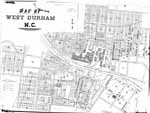 | Map of West Durham, N.C. Civil engineer C.M. Miller drew this detailed map of West Durham, North Carolina in 1910. He identifies street names for an area which is today largely associated with the Old West Durham neighborhood, Erwin Road and Duke's Central campus. The map identifies structures at the Erwin Mills and the size of homes owned by the textile company. It also indicates the location of churches and schools and identifies the names of some property owners. Scale 150 feet to the inch or [ca. 1:1800]. | |
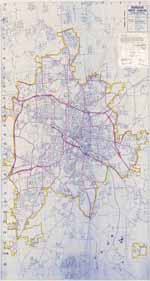 | Durham North Carolina Durham's Department of Transportation and Utilities produced this 1983 map in an effort to comply with the Powell Bill. This map contains an affidavit from engineer Kenneth E. Wright listing the exact miles of local roads and state highway roads. The map indicates that the City of Durham contained just over 484 miles of paved and unpaved streets in 1983. Public Works officials submitted this map to the North Carolina Department of Transportation in order to obtain funds for the maintenance of local roads under the "Powell Bill." | |
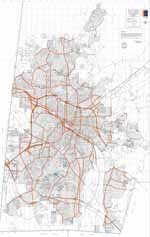 | City of Durham, North Carolina / Powell Bill Map F.Y. 1998-1999 The City of Durham produced this 1999 map in an effort to comply with the Powell Bill. This map demarcates the city line and identifies city system streets, private streets, 1997-1998 “city accepted streets,” dirt streets, interstate highways, United States highways, and state highway roads. City officials submitted this map to the North Carolina Department of Transportation in order to obtain funds for the maintenance of local roads under the "Powell Bill." The map contains an affidavit by engineer Richard Lee Murphy attesting to the validity of the data. | |
digitaldurham@duke.edu · About this site · Copyright © 2001 - 2006. Trudi J. Abel. All Rights Reserved.
The copyright interest in the material in this digital collection has not been transferred to the Digital Durham project. These text and images may not be used for any commercial purpose without the permission of the David M. Rubenstein Rare Book & Manuscript Library and the Digital Durham Project. Copyright permission for subsequent uses is the responsibility of the user.
